American Art History Digitallysponsored by the Terra Foundation for American ArtA Measure of Success: An African American Photograph Album from Turn-of-the-Twentieth-Century Connecticut
by Laura Coyle, with Mirasol Estrada and Allan McLeod
Laura Coyle is assistant director for cataloguing and digitization at the Smithsonian National Museum of African American History and Culture, where she is coeditor with Michèle Gates Moresi of the photography book series Double Exposure. Before joining the Smithsonian, she was curator of European art at the Corcoran Gallery of Art. She earned a PhD in art history from Princeton University, an MA in art history from Williams College, and a BA from Georgetown University. Her research specialties include modern and contemporary art, the history of photography, and the history of still-life painting.
Email the author: coylel[at]si.edu
Citation: Laura Coyle, with Mirasol Estrada and Allan McLeod, “A Measure of Success: An African American Photograph Album from Turn-of-the-Twentieth-Century Connecticut,” Nineteenth-Century Art Worldwide 23, no. 2 (Autumn 2024), https://doi.org/10.29411/ncaw.2024.23.2.24.
This work is licensed under a Creative Commons Attribution-NonCommercial 4.0 International License  unless otherwise noted.
unless otherwise noted.
Your browser will either open the file, download it to a folder, or display a dialog with options.
Scholarly Article|Interactive Feature|Conservation|Project Narrative
Despite its broken spine and other signs of devoted use, this photograph album of African American portraits from the Smithsonian National Museum of African American History and Culture (NMAAHC) kept the thirty photographs inside in good condition for more than one hundred years (figs. 1, 2).[1] The album’s early provenance is unknown, but its association with Connecticut is strong. More than half the photographs were taken in commercial photography studios in New Haven or Waterbury, Connecticut, and all the people identified in the album have a connection to one or both cities. A small, pink, printed label for J. H. McKinnon & Co., a stationer, printer, and book manufacturer in Waterbury, is pasted on the inside of the front cover (fig. 3). Between 1884 and 1891, J. H. McKinnon had a shop on 85 Bank Street in downtown Waterbury, where the album was purchased.[2] Based on what is known about the photography studios, the sitters, and the sitters’ clothing, the photographs date from the mid-1880s to about 1910.
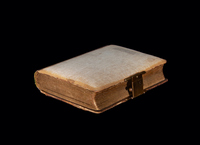
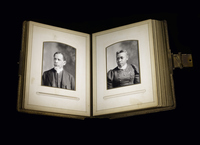
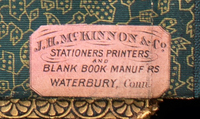
This album enacts the idea of Frederick Douglass (1818–95) that photographs of African Americans reveal the truth, showing Black people as they really are, not the way others assume them to be or the way they are represented in racist images.[3] In Douglass’s view, photographs of African Americans can narrow the gap between what they deserve as a people and how they are treated by the world around them.[4] This study demonstrates how the African Americans pictured in the album used photography to construct images of racial uplift, as theorized by scholars such as Deborah Willis.[5] It illuminates how the sitters capitalized on dress and portrait conventions to project middle-class status and convey excellent character. This study also shows how the compiler used the album to create a composite image of Black respectability and community grounded in family, friends, and church, a way of life prized by those it represented. These photographs fit into a long tradition of African American commercial portrait photographs, which began as soon as photography studios appeared in the United States and lasted for more than a century.[6] Often dismissed by photography historians as conventional and lacking in creativity, commercial photographic portraits can be, as Brian Piper argues, “typical and spectacular at the same time.”[7] The conventions of commercial portrait photographs provide a basis for comparison that allow for generalizations about the genre, but these photographs are also spectacular because of their realism and variation—each one clearly represents an individual.
Studio photographs like those in the album also helped African American sitters and viewers imagine and even achieve a better life for themselves. Coinciding with the compilation of the album, W. E. B. Du Bois (1868–1963) writes about the responsibilities of African Americans, contending that respectability, such as that cultivated by the sitters and represented in their photographs, was essential to the economic and social progress of Black individuals, families, and communities.[8] At the same time, adults associated with the album probably understood how fragile this progress could be. Tales about gains and losses, about where people in the album came from and what they were like, and about who they were at the time the photographs were taken and what happened to them thereafter are the types of stories that the family who owned the album surely told as they paged through it. Most museums and archives have not gone out of their way to collect photograph albums of unidentified people, especially African Americans, but the NMAAHC was eager to accept this album as part of its commitment to representing people who are and have been consistently overlooked. Reviving narratives associated with the album, to the extent possible, provides a more nuanced interpretation of the successes, challenges, and varieties of Black life and its representation in the United States around the turn of the twentieth century. As Mary Trent notes, family albums in museums and archives “introduce records that otherwise would fall through the cracks of recorded history.”[9]
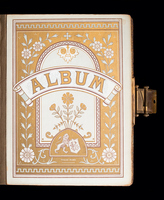
The album measures 10 ½ x 8 x 3 inches, about the size of a modest family Bible, which was the inspiration for the form.[10] Originally the cover was wrapped with textured brown leather or a leatherlike material. By the time the museum received the album in 2009, the covering was badly tattered, exposing much of the padded, linen-wrapped support for the cover underneath. The front of the title page is printed in green and white with gilt highlights (fig. 4). The design features an arch decorated with flowers and a scroll that displays the word “album” in gold capital letters. In comparison with other albums from the period, this one was modest; mail order catalogues carried albums in a wide range of prices, and many had much fancier outer covers and decorations.[11]
Whatever its cost, the album’s relatively understated design seems appropriate for the fashionably but not ostentatiously dressed people in the photographs. Most of the photographs are cabinet cards; they represent cherubic babies, stylish young women, dapper young men, compliant children, a respected minister and his wife, a well-known bishop, and a few older gentlemen. In addition to the photographs, the album includes photographs reproduced as halftone prints and a card memorializing the passing of a woman named Susan Bell, dated March 5, 1894. Albums with or without such memorial cards are reminders of the cycle of life and the passage of time, with family and friends represented in different life stages. Their images are records of the past that help to anchor memories.
The People in the Album
The people in the album photographs represent a span of generations, from those with firsthand memories, if not firsthand experience, of slavery to those born thirty-five or so years after the end of the Civil War, at the dawn of a new century. When the photograph album arrived at the NMAAHC, the names of most of the portraits’ subjects were unknown. Now, six people in the album are identified: Bishop James W. Hood (1831–1918); Rev. G. H. S. (George Henry Service) Bell (1838–1911) and his wife, Susan Bell (1836–94); Ida Allston (1872–between 1930 and 1948); Mary Evelina Allston (1888–1975); and Izetta Alexander (ca. 1861–1936) (figs. 5–10). In the Interactive Feature, stories about the people in the album are shared alongside the photographs, but it is useful to get to know here the sitters and their families as a group, focusing on the period of the photographs and the places that connect the identified sitters and their families.
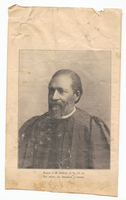
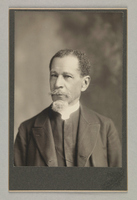
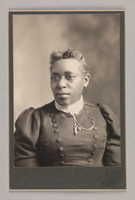
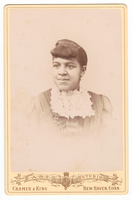
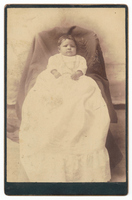
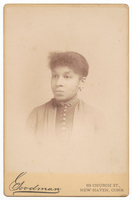
Just as women were the traditional keepers of the home, so the compilers and keepers of family albums were almost always female.[12] The Interactive Feature allows readers to page through the album at their leisure, in the same order the photographs appeared when the album came to the museum, starting with images of babies, enveloped in billowing christening gowns (figs. 11, 12). Whether the order of the photographs has remained unchanged is not known, but if the sequence created by the original owner has been preserved, presenting the youngest subjects first was an inversion of customary family hierarchy. Society at the time privileged adults, and among adults, men. This hierarchy, however, applied most often in the public sphere; while a man was usually considered the head of the family, affairs at home were traditionally the domain of women, who bore the children and, unless the family was wealthy, nurtured and raised the demanding newcomers. If the photographs are still in their original order, placing the images of the infants first signifies their importance to the album compiler and may have been an act of resistance to the male-dominated world outside the home.
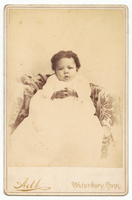
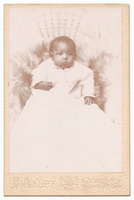
Even if the album photographs are not in their original order, aside from their sequence, together they have a leveling effect: each page in the album is equal to every other page, no matter who is represented. Access to fashionable but inexpensive clothing allowed even sitters of modest means to shine. The adult sitters capitalized on widely held assumptions of the time that fashionable clothing, careful grooming, a sober expression, and a stately pose, captured in a proper setting, projected middle-class values, such as propriety, accomplishment, refinement, learnedness, and integrity.[13]
The most prominent person in the NMAAHC album is Bishop Hood (see fig. 5).[14] Hood was born free in Pennsylvania, the son of a Methodist minister. In 1855, he moved to New Haven, Connecticut, where he worked as a waiter at the Torentine Hotel.[15] The next year, he secured a license to preach and gave his “trial sermon” at New Haven’s Varick Memorial A.M.E. Zion Church, where he is remembered as one of the most powerful preachers in the church’s history.[16] After a few years in New Haven, he was appointed as an unpaid missionary to Nova Scotia; he was ordained as an elder in Hartford, Connecticut; and he served in Bridgeport, Connecticut, for half a year in 1863, before moving to North Carolina, where he lived for the rest of his life. He helped establish Zion Wesley Institute (now Livingstone College) in Salisbury, North Carolina; he presided over the North Carolina Freedmen’s Convention in 1865; he participated in the state constitutional convention and the Republican national convention in 1872; and he served as an assistant superintendent of the North Carolina Freedmen’s Bureau.[17]
The compiler of the album may have included Hood because she knew him or simply because she held him in high regard. While this is a family album, albums of this type in the nineteenth century often included photographs of friends and people the compiler admired as well as kin.[18] In his bust portrait, probably taken in 1894, Bishop Hood is posed formally, in three-quarter profile, wearing his pleated clerical robe, which identifies him as a man of the cloth. His portrait supports a description of him as a man who “wears his dignity with great ease and is one of the most fatherly Bishops of the age.”[19]
Bishop Hood authored a history of the A.M.E. Zion Church that includes a biography of Rev. George Henry Service Bell, who went by G. H. S. Bell (see fig. 6).[20] Bell was born free in Bermuda to parents who had recently been emancipated. He married Susan (see fig. 7) in Bermuda, where they had their only child, Samuel Bell, born in about 1858.[21] G. H. S. Bell owned his own business in Hamilton, Bermuda, then taught in a government school for fifteen years before studying for the Episcopal ministry. Hood writes in his church history that in about 1856, Bell “became interested in the subject of colored churches and their ministry . . . [which] rekindled his childhood ambition to be a ‘preacher of the Gospel.’”[22] He was granted a local preacher’s license in 1872. In April 1880, Bell traveled to the United States and visited the A.M.E. Zion Conference in New Haven, where he applied for membership, was accepted, and was sent to serve in Cambridge, Massachusetts, the first of many New England cities to which he would be appointed. He probably served in Waterbury from 1892 to 1894 and again from 1896 to 1900.[23] By 1902, he was serving as presiding elder of the New England Conference.[24] It seems likely that the compiler of the album’s photographs was acquainted with the Bells, because the inclusion of Susan Bell’s memorial card in the album suggests she attended the service. Rev. Bell remarried in 1895, and was living in Hartford with his wife Mary when he died in 1911.[25]
In his biographical sketch of Bell, Hood writes:
Brother Bell is a man of high Christian character and greatly loved by his people. During the long period that he has held the position of Conference steward his accounts have been well kept, and not a cent has gone astray, and the expense of running the office has been exceptionally and surprisingly small. We venture the assertion that no living man is more straightforward or trusty in his dealings.[26]
For their portraits, taken in early 1894 while the Bells were assigned to Waterbury, Rev. and Susan Bell dressed soberly and appropriately for their roles in the community as pastoral leader and pastor’s wife.[27] Bell’s close-cropped hair is still mostly dark, but his walrus mustache and beard are nearly white. He wears a coat over a waistcoat with a notch at the top of its placket that highlights his bright white clerical collar. A cord or chain across his chest is perhaps attached to eyeglasses hidden in his waistcoat pocket. He looks dignified and trustworthy, reinforcing his reputation as a careful yet approachable steward. Mrs. Bell looks thoughtful and serious. She wears spectacles, which may have signaled at the time that she was literate and educated.[28] Her dark dress with a ribbed pattern has a snug bodice decorated with orderly rows of covered buttons; around her neck she also wears a white collar, for the sake of fashion rather than the dictates of the Church. The leg-of-mutton sleeves of her dress are also stylish, puffed around her upper arm and tight below the elbow. Her hair is pulled back tightly at the sides, with bangs that are clipped back. Her gold watch chain is pinned to her collar; one length of the chain is weighted and decorated with fobs while the other dips across her chest, then tucks into her bodice, locating her pocket watch out of sight and harm’s way. She passed away within weeks or days of this photograph and may have been unwell, perhaps explaining why she looks so somber.
Well educated and well respected, Rev. Bell likely held an elevated place in Waterbury’s social hierarchy, although many elite African Americans at the time belonged to the Episcopal or Congregational Church.[29] Nonetheless, Mount Olive A.M.E. Zion Church was the city’s first Black church—and the only Black church until 1900.[30] Mount Olive is still active and may be the oldest continually operating Black institution in Waterbury.
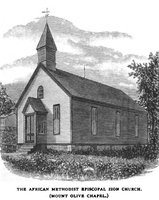
Fundraising for Mount Olive church at a site on Pearl Street began in 1883, when between only 133 and 171 African Americans lived in Waterbury (fig. 13).[31] By 1891, the church was “renovating, refitting, painting, papering, and building an addition at a cost of $869.69.”[32] Rev. Bell was serving elsewhere when the Southern Section of the New England Conference convened at Mount Olive A.M.E. Zion Church in 1906, but he likely attended as treasurer of the conference.[33] Along with services, Sunday school, and other religious instruction, Mount Olive hosted many social events, such as concerts, lectures, and meetings of the J. C. Price Historical and Literary Society.[34] During the period of the album’s compilation, Mount Olive was the heart of Waterbury’s African American community.
The members of Mount Olive probably joined other Black churches in the area for frequent picnics, such as the ecumenical Union Excursion in 1890 that attracted one thousand people to High Rock Grove, a setting with “romantic and weird-like scenery” in Naugatuck, a town adjacent to Waterbury.[35] The organizers also invited the members of the African American lodges and other associations in New Haven, Waterbury, and other nearby cities.[36] Membership and leadership in Black churches often overlapped with membership in Black fraternal societies such as the Prince Hall Masons and Grand United Order of Odd Fellows of America as well as their sister organizations, Order of the Eastern Star and Grand Household of Ruth.[37] Bishop Hood was a Mason, and while pastor at New Haven was instrumental in establishing Connecticut’s Masonic lodges.[38] Rev. Bell was also a Mason.[39] African American Churches, fraternal and sororal organizations, and other clubs and societies provided social and service opportunities for African Americans who were denied admittance to white-run organizations, and helped them to build professional and social networks and leadership skills. Out-of-town events like church picnics and balls encouraged the small Black populations in Connecticut cities and towns to engage in and create ties within a more expansive African American community.

In addition to Bishop Hood and the Bells, Ida Allston is firmly identified in the album (see fig. 8). Ida was well-known enough that she appeared in stories about Waterbury society in one of New York’s African American newspapers, New York Age. The paper reported in January 1891 that “Miss Ida Allston of New Haven is visiting her sister here [in Waterbury], Mrs. F. M. Robinson,” whose first name was Sarah.[40] Ida was probably born in Philadelphia, married Richard W. Brown (1869–1919) in about 1893, and lived with her family in New Haven until about 1921 or so.[41] In the US census of 1900, Richard’s occupation is listed as locksmith.[42] A decade later he is listed as a machinist who owned his own home, working at Sargent & Company in New Haven, one of the city’s major hardware manufacturers.[43] Maybe Richard is the well-dressed man with two pins adorning his necktie, one a gem and the other decorated with a key on a scroll (fig. 14). This photograph, probably taken between 1890 and about 1900, shows an intently focused man, neatly attired in a coat with trimmed lapels and a matching waistcoat. His shirt with folded collar points is perfectly pressed and sets off a wide, knotted tie. The hair on his balding head is combed down, a contrast to his wiry sideburns and generous moustache. He comes across as serious, proper, tidy, and intentional.
When Richard died in 1918, Ida became a widow, with five children between the ages of about eight and twenty-four years old. She was listed as head of her household in 1920, working as a nurse. She still owned the home inherited from her husband, next door to her parents, and was living with three of her children.[44] In 1923, Ida married Daniel Scott (1856–1948) in New Haven; by 1925, they were living in New York City with her two youngest children.[45] Ida died sometime between the time when the US census was conducted in 1930, and 1948.[46]
Ida, of course, had no idea that all this would happen in her life when she posed for her portrait between 1888 and 1891. At that time, she was between sixteen and nineteen years old. Despite her grown-up hairstyle, dress, collar, and drop earrings, she still seems very young, with the chubby cheeks of a child. Her hair is parted on the side and pulled back, with heavy bangs on her forehead. This was the current style, but the bangs must have been a challenge for young women such as Ida, with curly hair. The bodice of her dress looks relatively plain, in a solid color pleated down the front, but it is dressed up with a detachable, starched, ruffled-lace collar that seems to have a life of its own. Her head is turned slightly to the right, she seems to suppress a smile, and her eyes are lively and bright. She presents herself as fashionable but proper, and at ease with herself and the world.
Ida’s sister, Mary Evelina Allston, is one of the infants pictured in the album (see fig. 9). Looking none too happy about being photographed, Mary Evelina is propped up on a chair covered with an embroidered blanket, setting off her long, billowing christening gown. Her wavy hair is smoothed down, and she wears a chain around her neck. As the abundance of baby pictures that survive from around the turn of the twentieth century attest, an addition to the family was something to celebrate and visually commemorate, an event worth the effort of dressing a baby in a fresh, snow-white gown; traveling to the studio; perhaps making a climb up the stairs to the top-floor, babe in arms; and risking a mess or a meltdown, all for a set of twelve cabinet cards, one or two to keep and the rest to give away.[47] Many babies did not survive their first year of life, and until emancipation, many African American families could not count on staying together. The birth of a healthy, Black baby, like Mary Evelina, who would remain with her family until she was an adult, was not to be taken for granted. Particularly for African Americans in this period, an air of poignancy hovers over baby photographs.
Going by a bewildering variety of first names vexing to amateur genealogists—Mary, Evelina, Evelyn, Evalinia, and Mary Evalina—Mary Evelina was the youngest of Ida’s five siblings, born while the family lived in New Haven.[48] When she was eight years old, Mary Evelina is mentioned in a Black-owned newspaper in Virginia, the Richmond Planet, in an account that adds texture and humanity to the official records about her and her family:
A pretty home wedding was performed by Rev. W. H. Coffin, D.D., on the evening of March 3rd [1897], at the residence of Mr. and Mrs. James Allston, 133 Butler St. The contracting parties being Miss Rebecca Lauretta Allston and Mr. Henry Scroggins, both of this city.
The bride was attired in a pretty gown of cream colored crepon with lace trimmings. The floral ornaments were white carnations. The groom wore the conventional evening dress suit.
The bride was given away by her father. Little Evelina [Mary Evelina Allston], sister of the bride, was flower girl, with the bride’s little nieces, Ethel [Ethel Isabella Robinson (b. 1893)] and Beatrice Robinson [Florence Beatrice Robinson (1896–1979)], the attending maids.
Beside the family, which is a very large one, including Mr. and Mrs. F. M. Robinson, of Waterbury, Conn., there were present Mrs. S. Pheonix [sic] and daughter, the latter presided at the piano and rendered several beautiful selections, after which all enjoyed refreshments and a grand social evening. Mr. and Mrs. Scroggins are enjoying the congratulations of legations of friends.
The happy couple will reside at 133 Butler Street for the present.[49]
One of the intriguing things about this notice is that a wedding in New Haven made the front page of a newspaper in Richmond, Virginia. Connecticut did not have an African American newspaper, and during this period stories like this one about African American families in a white-owned newspaper in Connecticut were rare. Consequently, African American correspondents around the state sent notices about Connecticut social events to a variety of out-of-state, Black-owned newspapers, which had subscribers all over the country. Perhaps the Allstons had friends or relatives in Richmond, but even so, other readers must have enjoyed these stories as examples of racial progress, prosperity, and uplift, even if they did not know the people involved.
By 1920, Mary Evelina was lodging in New York City with her brother James, a hotel cook, and Joseph Da Costa (1880–between 1942 and 1950), a sexton at a church. Joseph was born in Saint Kitts, in the British West Indies, to an English father and a Portuguese mother.[50] He arrived in New York by way of Hamilton, Bermuda, in 1903. In 1921, he and Mary Evelina married.[51] By 1929 they had two children, Rosalie Regina and Joseph.[52] They lived in New York City. Joseph Sr. petitioned for naturalization several times, but it is not certain that he obtained citizenship by the time he died, sometime between 1942 and 1950.[53] The only known photograph of him is clipped to one of these sets of naturalization papers. In the US census of 1940, Mary Evelina is listed as a pianist for a theater.[54] She later lived with her son and died in Brooklyn in October 1975.[55]
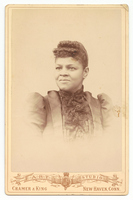
One of the women among the unidentified cabinet-card photographs (fig. 15) may be another Allston sibling, Sarah Allston (1870–1949), the older sister—“Mrs. F. M. Robinson”—that Ida visited in Waterbury. Dressed and posed similarly and photographed in the same studio as Ida, she strongly resembles her, with the same-shape face, large, wide-set eyes, strong eyebrows, and a similar nose and mouth. Like Ida, she wears her hair up, with curly bangs, and her solid-color dress is gussied up with a lace collar, though her collar is black. The bodice of her dress is also more intricate, with pleats and lapels, and the sleeves are significantly puffed at the shoulders, a style that came into fashion in the early 1890s. Although posed like Ida, with her head turned to her right, she has a completely different bearing. Clearly older than Ida, she appears more mature and confident, with a no-nonsense demeanor. She would need this fortitude, as she gave birth to ten children between 1890 and 1913 and raised eight to adulthood.
Sarah was born in Philadelphia in 1870 and moved with her parents and siblings Ida, Rebecca Lauretta, and James to New Haven by 1881. In about 1888, around the time the photograph in the album was taken, she married Foster Marshall Robinson (ca. 1860–1920). Born in South Carolina, he was in New Haven working as a blacksmith in 1887 and as a waiter in 1888.[56] Foster belonged to the Widow’s Son Lodge 1, Free and Accepted Masons, in New Haven.[57] Not long after he and Sarah moved to Waterbury, he was in business for himself as a truckman.[58] Their first child, Emma Elvira, was born in 1889.[59] A few years later, the family was living on Pearl Street across the street from Mount Olive Church; the barn Foster rented for his business was on the same site.[60] In 1895, catastrophe struck:
An alarm of fire was rung at 2:30 this morning . . . and soon the noise of the big gong . . . could be heard all over the city. The fire was discovered in a barn belonging to Francis De Bussy, 75 Pearl Street, which was used by F. M. Robinson, a colored man, and contained a valuable horse, carriage, express wagon, a quantity of hay and other things, all of which, with the building, were totally destroyed, the horse also perishing in the flames. The loss is estimated at $300. Robinson had no insurance on his property. The noise of the horse awakened several of the neighbors, and great efforts were made to save the animal, but when assistance arrived, it was too late to do anything, for the whole building was enveloped in flames. There is no clue to the origin of the fire but it is believed to have been the work of an incendiary.[61]
Somehow, Foster recovered. He listed his business in the Waterbury and Naugatuck Directory, in which the editions from 1899 through 1906 included a paid advertisement.[62]
In addition to being neighbors to Mount Olive A.M.E. Zion Church, Foster and Sarah were among its active members.[63] Perhaps some of the babies or children in the album who were photographed in Waterbury are Robinsons who were christened there. Foster and Sarah lived in Waterbury until 1907, when they moved with their children to Becket, Massachusetts, where they bought a farm.[64] Mount Olive held a farewell reception in honor of Foster and his family.[65]
Perhaps Foster is the solemn young man in a long, double-breasted coat, a sprig of flowers placed in a buttonhole, pictured in one of the album’s photographs (fig. 16). He stands with one hand behind his back, a common pose, and holds a walking stick in his other hand. The date of the photograph, gleaned from records about the studio, coincides with the year he and Sarah married. The photographer lightened the area under his chin, a technique frequently used to define the faces of people with dark complexions. Someone later embellished the sitter’s neatly trimmed moustache and his stand-up collar. He projects quiet confidence and a sense that he is prepared for whatever life sends his way.
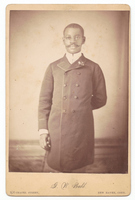
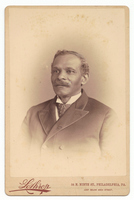
Given Foster’s trade, he also could be the man with the horseshoe stickpin in the photograph taken around 1890 (fig. 17). The name Sarah Robinson, Foster’s wife, appears on the back of this picture. The cabinet-card photograph was taken in Philadelphia, however, and the man appears much older than Foster would have been in the 1890s, so it seems more likely that the photograph is of Sarah’s maternal grandfather who lived in Philadelphia, William H. Crawford (ca. 1823–90). A lucky horseshoe would have had special meaning to him, because he was employed as a driver and messenger.[66] Dressed neatly in a heavy, double-breasted coat, white shirt, and patterned tie, he looks a bit weary, yet dignified and solid. Carefully groomed, he presents as a man who is proud of what he had achieved over a long life.
As the New Haven newspaper noted, Ida, Mary Evelina, and Sarah grew up in a large family, which was headed by James Allston (1843–1911) and Anna Crawford Allston (1848–after 1910).[67] James was born in North Carolina. Anna, born in Georgia, had moved with her parents and her younger siblings to Philadelphia by about 1854.[68] James and Anna married in about 1869 and lived in Philadelphia before moving to Connecticut with their four children.[69]
James worked as a cook, as a janitor for Yale University, and as a chef at St. Margaret’s Episcopal School for Girls, a boarding school in Waterbury.[70] In 1900 he opened a restaurant in Waterbury with resident Mack Jones.[71] Although the restaurant did not last, for several summers James was a popular cook at a Y.M.C.A. camp on Tuxis Island, near New Haven, “doing a great deal in the way of improving the camp” and entertaining the boys by singing spirituals.[72] And he could dance! In 1901, he entered a cakewalk contest held in an open-air theater in Forest Park in Waterbury, where a report notes “there promises to be some lively stepping among the contestants for that first [cash] prize.”[73]
By 1910, James and Anna Allston had separated; for many African Americans, emancipation brought not only the legal right to marry but also the right to divorce. Anna moved to New York City, where she lived with her widowed mother and worked as a nurse.[74] James lived in various places, including Waterbury and Becket, with his daughter Sarah and son-in-law Foster.[75]
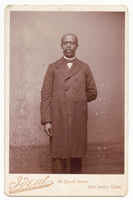
James could be the man in the long, black coat in a photograph (fig. 18) taken in New Haven in 1894 or 1895. If so, he would have been about fifty years old, which seems about right for this photograph. Wearing a white shirt with a crisp, stand-up collar, a satin bow tie, and a long, partially buttoned, slightly rumpled, double-breasted coat, he was photographed against a stark background, almost full-length, with one arm bent behind his back. He represents himself as upstanding, literally and figuratively, and self-sufficient, with no need to lean on anyone or anything. But the man in this photograph appears dour, not what one would expect from newspaper descriptions of James.
The last sitter whose identity is known is dressmaker Izetta Alexander (see fig. 10). Born in Rhode Island, she lived in New Haven and Waterbury until marrying and moving to Long Island around 1916.[76] In 1887, she was named secretary of the first African American branch in Connecticut of the interdenominational Young People’s Society of Christian Endeavor.[77] In 1900, she is listed in the US census for Waterbury as a servant living at St. Margaret’s School, where James was a chef, but at the same time, she was listed as a dressmaker, boarding in her parents’ home in New Haven.[78] As a single woman, she may have had to hold more than one job to support herself.
Also in 1900, Izetta was arrested for attacking her “sweetheart,” Johnson Haile, the handsome headwaiter at Scovill House in Waterbury, by the gate of St. Margaret’s School. The Bridgeport Sunday Herald, a white-owned newspaper, printed a sensational front-page story, framing the crime as
[t]he oft repeated tale of a woman of a certain class driven to the verge of insanity by jealousy and who for the time being is a maniac, thinking of nothing but her overwhelming love for a man who once professed to love her but who turned aside for another face and threw his promises and her heart to the winds. . . . Women of a certain class can hate even more fiercely than they have loved and the Alexander girl was one of these.[79]
This description of Izetta as a “woman of a certain class” may have been racially motivated and biased, and was certainly at odds with her demure photograph, taken in 1888 or 1889, when she was about twenty-seven years old. She wears her hair pulled back, except for a stylish fringe of bangs, and simple hooped earrings. She is tidily attired in a jacket worn over a high-button bodice, which she probably sewed herself, the bodice chastely fastened at her throat. She looks proper, serious, and wary, the opposite of the impulsive woman described in the newspaper.
According to the newspaper, Haile may have had it coming:
Johnson Haile has had years enough of experience with women and the world. He was a ladies’ man. He seemed to have solved the problem of capturing the affections of every woman he went after, colored or white, and he played fast and loose with them. He was popular. Everyone liked him, but many of his friends shook their heads and predicted that one day he would come to trouble. It was especially known that the Alexander woman was in love with him and that he had thrown her over.[80]
Another white-owned newspaper noted:
Every effort is being made to adjust the case without the interference of the city court. The accused’s friends are prominent in various churches. They are fully aware of the seriousness of the case, yet they say it was not done without serious provocation. Haile is well known as somewhat of a gay Lothorio and his own statement that he will withdraw the complaint providing the accused leaves the city is considered as evidence that he had grievously irritated her.[81]
Haile refused to prosecute, and the case was settled out of court for $100, about $3,700 today, possibly due to the intervention of Izetta’s friends.
Admittedly, Izetta had committed a terrible crime, but the long newspaper accounts expounding on Alexander’s and Haile’s characters lean a little too enthusiastically toward widespread, negative sentiments among white people that Black women were angry, argumentative, and emasculating and that Black men were hypersexual. These harmful stereotypes would gain even more traction in the media in the twentieth century.[82] Formal commercial portraits portraying African Americans as highly respectable, like the ones in the album, were a way Black people could intentionally present themselves to push back against these stereotypes.
Izetta could have had photographs taken after 1900 to help mend her reputation. A photograph projecting respectability was desirable because in the late nineteenth and early twentieth centuries, cabinet cards circulated widely among family, friends, and suitors, and one’s photograph could have a direct impact on one’s fortunes. An illuminating source for the social use of photographs among African Americans is the diary kept by journalist and activist Ida B. Wells-Barnett (1862–1931). The diary dates to 1885–87, when Wells-Barnett was in her early twenties, living in Memphis, and not yet married. Earnestine Lovelle Jenkins notes in her study of nineteenth-century photographs in Memphis that Wells-Barnett mentions photographs, pictures, scrapbooks, and photograph albums in her diary at least forty-two times.[83] Wells-Barnett commissioned and traded photographs frequently to promote her active social life. Given the number of photographs of African Americans from across the country that survive from this period, Wells-Barnett’s love and use of photography was probably typical of other middle- and working-class Black Americans (figs. 19, 20, 21, 22). In her diary, she describes how trading photographs worked. Jenkins writes:
In general Wells exchanged photographic cards with suitors who first offered a photograph and then asked for one of hers. In 1885, a young man referred to as E. W. M. brought her “a fine cabinet photograph” when he called upon her one evening in April. She in turn “gave him one of mine.” In some instances photographs were used to renew an acquaintance. Around the same time, Wells wrote to a Mr. Avant asking him for a picture to renew their friendship, which he agreed and promised to do.[84]
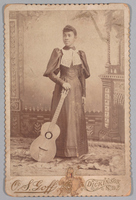
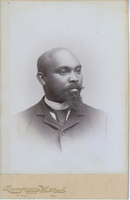
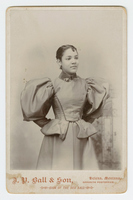
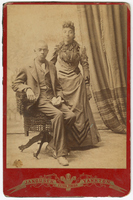
In her early twenties, Wells-Barnett often wrote to the men who were her escorts and companions. Jenkins observes:
Whenever a letter she received was accompanied by a photograph, she took the time to study it. For example, she found a letter from Mr. Morris most interesting but upon first receipt of his photograph was surprised to learn how young he was. . . . While she honored his request for a picture of herself, she asked for its return because it was borrowed. She did, however, promise to “send him a picture of his own when she had her cabinets taken.”[85]
On one occasion, a friend of Wells-Barnett gave a photograph of her to an interested suitor without her permission. He showed it to his friends, and when Wells-Barnett found out, she was very offended. She was also annoyed when she requested back two photographs from a man she was no longer interested in, and he returned only one.[86]
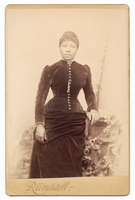
It is easy to imagine the young men and women portrayed in this album’s “cabinets” engaging in the same practices. The uncertain path to a perfect match and the pains people took to maintain friendships and cultivate relationships, often by mail, helps explain why people dressed and staged their photographs with such care as well as why they ordered cabinet cards by the dozen. One can also understand why a young man in possession of a photograph like the one of a woman in a velvet gown (fig. 23) might be reluctant to return it upon request, or why a young woman might be annoyed if a photograph she requested back was not returned. For single male and female sitters, how to stand out and appear attractive to their peers while still conforming to fashion and norms of respectability was challenging but necessary.
African Americans in the Post-Reconstruction Era
While the experiences of each African American person, family, and community are unique, for African Americans overall the years after the end of Reconstruction in 1877 and into the early 1900s were a difficult and tumultuous time.[87] The United States was transitioning from an overwhelmingly agrarian society, which had been highly dependent on slavery, to one that was increasingly industrial and urban, which by law enshrined some rights but not equality. Many in the South were trapped in sharecropping arrangements that impoverished them, while prejudice and racism everywhere limited opportunities for African Americans to advance. The Thirteenth, Fourteenth, and Fifteenth Amendments granted African Americans freedom, citizenship, equal protection under the law, and the right to vote, but most political gains African Americans made during the era of Reconstruction (1865–77) were rolled back swiftly. White people who refused to relinquish or share power launched campaigns to intimidate Black Americans that robbed them of their rights and sometimes their lives. Jim Crow laws throughout the South mandated segregation in nearly every area of public and private life. While by the 1890s African Americans as a group lived better lives than enslaved people had by many measures, in terms of health, income, and literacy and mortality rates, they were still far behind average white Americans.
Despite these obstacles, African Americans persevered, fighting for better lives for themselves and their children. With the collapse of gains made under Reconstruction and the failure of traditional institutions and organizations to support them, African Americans provided their own networks of support, as they had always done, to improve living conditions, education, and opportunities for themselves.[88] Glenda Elizabeth Gilmore reminds us that “[t]he period from 1890–1920 is often called the ‘nadir’ of African American history, yet African Americans kept hope alive.”[89]
By 1890, some Black people from the South had migrated to the North and West, but more than 80 percent of African Americans remained in states that were formerly slave-holding states.[90] In the Northeast, New York had the largest population. By 1900, Connecticut’s state’s population was 908,420, but only 15,226 were African American, 1.7 percent.[91] New Haven was the city with the most African Americans, 2,887 people, 2.7 percent of the population.[92] The number and percentage of African Americans in Waterbury was smaller, only 540 people in 1900, 1.2 percent of the population, and 775 in 1910, only 1.1 percent of the population.[93]
Across the United States, a third of African American men and half of African American women were in domestic or personal service.[94] More than half of employed African American men worked as farmers or in other fields of agriculture. In the Northeast, where the photographs were taken, the employment story was different for Black and white Americans, mainly because agriculture was a much smaller part of the economy.[95] As in other Connecticut cities, one industry dominated in New Haven, hardware, and in Waterbury, brass production. Consequently, African Americans in Connecticut rarely worked on farms, but due to discrimination, neither did most work in the coveted skilled-manufacturing jobs Connecticut’s cities offered.[96] Overwhelmingly African Americans in Connecticut around the turn of the century were laborers or in domestic service.[97] Ida Allston Brown’s husband, Richard, who was a machinist in a large New Haven company, was exceptional.
There was a mix of skilled and unskilled occupations in Connecticut with a high percentage of African Americans, including draymen, teamsters, and expressmen; janitors and sextons; and waiters.[98] James Allston worked as a chef and janitor, one a skilled and the other an unskilled working-class job, yet it appears he earned enough to support a middle-class lifestyle for his family. Foster Robinson worked as an expressman, owning his own business and his own home, where his wife worked full-time keeping house for their large family. Compared to unskilled trades, skilled trades offered greater economic stability, better pay, and the potential for advancement. It is difficult to know where clergy fit in the Connecticut job classifications. Rev. Bell had also been an entrepreneur, and he had a good education; in their photographs he and Susan Bell present themselves as quite refined. Their well-being, however, depended on the economic health of the community where they were assigned, which supported the church and provided the parsonage. In Waterbury and other cities in Connecticut, nearly all African American men around the turn of the twentieth century were employed, and, as a group, the African American population was making its way forward.
For many, a better education was a path to a better life. By 1895, 1.43 million African Americans in former slave states were enrolled in school, close to triple the number in 1876.[99] Literacy rates overall skyrocketed, from about 5–10 percent under slavery to over 50 percent by 1910.[100] In 1868, Connecticut prohibited discrimination in schools based on race and made public education free, but Waterbury had already allowed all children between four and sixteen years of age to attend school.[101] According to the US census of 1900, close to 100 percent of African American school-aged children in Waterbury attended schools, and nearly all African American adults in Waterbury, including all those identified in the album, could read and write, which increased opportunities for employment. Literacy rates in other Connecticut cities were probably similar.
Rarely were African Americans in Connecticut subject to the violence they experienced in many other places. They were tolerated, if not welcomed, by the majority of the state’s populace. W. E. B. Du Bois writes that white people often thought African Americans living in New England and the Middle Atlantic states had “not formed to any extent a ‘problem’ in the North, that during a century of freedom they have had an assured social status and the same chance for rise and development as the native white American, or at least as the foreign immigrant.” But “this,” Du Bois says unequivocally, “is not true.”[102] Yet based on existing documentation, and despite obstacles and ups and downs, the people in the album and their families appear to have been more secure financially than most African Americans of their era, including others in Connecticut.[103] Making up such a small minority of the population was a big change for most of the African Americans in the state, who were recent migrants from the South.[104] Several of the people associated with the album, however, were born in the Northeast or had left the South before the Civil War. Because they were better established, they may have been better adapted for success in the Northeast than more recent migrants.
The African Americans in the album represent themselves as middle class, as people who had found a measure of success despite the odds. Even if middle-class status for some of them was aspirational rather than actual, their images project hope, confidence, and pride in what they had achieved. And a fine collection of turn-of-the-twentieth-century portraits in an African American family album also stood for something else: the privilege of collecting photographs of an intergenerational family, one that ancestors who had been enslaved were denied.[105]
Early Photography and African Americans
The role and significance of photography for nineteenth- and early twentieth-century African Americans cannot be overstated. Shortly after photography was invented in 1839, enterprising Americans, including African Americans, opened daguerreotype galleries and parlors around the country.[106] Americans enthusiastically embraced this revolutionary new picture-making technology, and Black Americans appeared in such photographs from the start.[107]
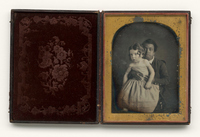
Daguerreotypes, however, were expensive, and very few African Americans could afford them.[108] Around 1850, when they were most popular, the largest, a full- or whole-plate daguerreotype, could cost thirty-three dollars—in today’s dollars, $1,300. Even the smallest examples cost between about fifty cents and $2.50, a stretch even for skilled laborers, who in 1860 earned an average of $1.62 per day. Daguerreotypes were out of reach for typical farm laborers, who at that time averaged $13.93 a month, never mind for unskilled labor or the enslaved.[109] Consequently, most daguerreotypes of African Americans were commissioned by their owners to document the owners’ “property,” with African Americans often literally pictured in supporting roles (fig. 24).[110]
Despite the expense, some African Americans commissioned daguerreotype portraits of themselves (fig. 25). The most famous of these is Douglass, the best-known African American and most widely photographed American of the nineteenth century.[111] Douglass used photography to shape his public persona and confront stereotypes about African Americans with dignified and powerful portraits that, along with his oration, “sent a message to the world that he had as much claim to citizenship, with the rights of equality before the law, as his white peers” (fig. 26).[112] The earliest photograph of Douglass, a daguerreotype from 1841, shows him as a young man, about three years after his escape from slavery, around the time he started his crusade as an abolitionist speaker.[113] This was one of 160 photographs of Douglass taken over a period of fifty years.[114]
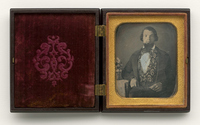
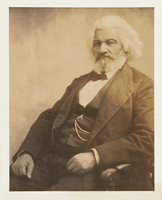
By the end of the 1850s, much cheaper alternatives to daguerreotypes had emerged, including ambrotypes and sturdy tintypes, which were often encased like daguerreotypes, and cartes de visite.[115] Produced at the same small size the world over, cartes de visite found homes in the first mass-produced photograph albums by 1860.[116] Inserted among cards from family and friends were those of famous people such as Abraham Lincoln (1809–65), Douglass, Harriet Tubman (1822–1913) (fig. 27), and Sojourner Truth (ca. 1797–1883), the last of whom used cartes de visite to take charge of her own image as a free woman (fig. 28).[117]
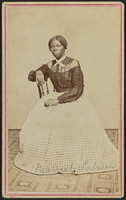
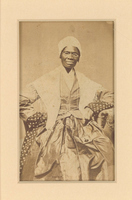
Cabinet cards, invented in 1866, were enormously popular by the 1880s; they are the dominant type of photograph found in the NMAAHC’s family photograph album. These photographs were larger than carte-de-visite photographs and were mounted on more substantial cards. They could be easily propped up on a shelf and did not bend and crease when sent through the mail. As Jenkins notes, “the edges of the cabinet cards were framed or enhanced to make portraits more elegant. Flattering positions and more ornamental backdrops and props helped the sitter appear more cultivated” (figs. 29, 30).[118] In addition, the extra length at the bottom of the card allowed the photographer to record the studio name and location on the front, underneath the photograph, and some studios also added advertising on the back of the card.[119] Photographers were listed consistently in city directories; they frequently relocated and went into and out of business, so cards with studio names and street addresses are often easier to date than those without.
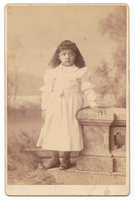
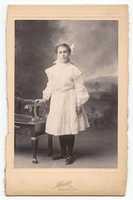
By the 1880s, photographers had created landscapes, still-life compositions, scenes of everyday life, and even historical tableaux.[120] But for at least another decade or two, formal portrait photographs, taken in a commercial studio, were by far the most popular photography genre among all Americans, including African Americans.[121] The cost for a set of a dozen cabinet cards ranged from two to six dollars, an affordable luxury even for working-class people.[122] In turn-of-the-twentieth-century studios, the poses, lighting, and backdrops varied, but not by much. Even small cities like Waterbury and New Haven had several photography studios. Although all the studios in Waterbury and New Haven that are represented in the album had white owners, at least one studio in New Haven, the name of which is unknown, employed an African American: Richard Brown, Ida Allston’s son.[123] Black employees might have helped attract, photograph, and keep Black clients, but in any event, the African American sitters in the album went to white-owned studios and obtained dignified, attractive portraits. Where competition existed, studios produced acceptable likenesses, or their clients would take their business elsewhere.
Very few photograph albums, including albums of African Americans, have been researched and published, and even fewer are late nineteenth- or early twentieth-century family albums.[124] Most museums and archives do not collect photograph albums of unidentified people, especially African Americans.[125] Intact albums rarely appear on the market. The historical and regional coherence of photographs in the NMAAHC album, a fact supported by research, strongly suggests that they belong together, but as Henish Heinz notes, old photography albums “offered for sale have usually been raided for valuable contents, then ‘reconstituted’ by inserting photographs from a random pile, without historical cohesion, just to fill in the vacant spaces.”[126] Perhaps the most important reason few photography albums owned by Black families are collected and published is that they are retained and treasured by those families.
More recently, scholars and curators have paid more attention to ordinary, often commercial, photographs compiled in albums, believing, as Trent does, that “album-based archives are born in the gaps between dominant narratives,” countering “institutionalized acts of neglect, marginalization, misrepresentation, or erasure.”[127] Portrait photography of famous, little-known, and even unknown people calls for investigation into the role and potency of photographic representation. Often the emphasis of this work is on how photographs reinforce power relationships, but Trent is convincing when she argues that scholars “have overemphasized the dominance of European and North American, middle-class, white, heterosexual, feminized, ableist identity and visual power in operations of photography albums and scrapbooks.”[128] Studying how everyday people used photography can be particularly revealing when the subjects of the photographs were marginalized in their own time or have rarely been the subject of historical research.[129]
Frederick Douglass and Photography
“This may be termed an age of pictures.”[130] So proclaimed Douglass in 1862 in one of four speeches about photography he gave between 1861 and 1864–65, expounding on the topic more than any of his American peers.[131] These speeches are valuable for understanding the power and meaning of early photography for Black Americans. Douglass celebrates the verisimilitude and accessibility of photography:
A very pleasing feature of our pictorial relations is the very easy terms upon which all may enjoy them. The servant girl can now see a likeness of herself such as noble ladies, and even royalty itself, could not purchase a hundred years ago. Formerly the luxury of a likeness was the exclusive privilege of the rich and great; but now, like education and a thousand other blessings brought to us by the advancing march of light and civilization, such pictures are brought within easy reach of the humblest members of society.[132]
While the extraordinary ability to create a strikingly real portrait and the democratic nature of photography were two of the reasons that Douglass loved photography, these were not the only ones. He also posits photography’s potential to prove to white people the humanity of Black people and to help end slavery.[133]
This was a tall order. To understand how Douglass thought this was possible, it is useful to understand the type of photographs that he discusses. He is referring to photographs like those he had had taken of himself: formal, stylized portraits commissioned by the sitter, in which the sitter presents himself at what he considers his very best (see fig. 26). This form of picture making was objective but also deliberate. Henry Louis Gates Jr. notes that Douglass “presented a range of selves over time,” but every image is dignified and imposing, which shaped and still shapes his public persona.[134] For Douglass, a truthful photograph communicated to his peers and to those who would come later not only his appearance but also his character, which he hopes will inspire them. “It is evident,” he writes, “that the great cheapness and universality of pictures must exert a powerful, though silent, influence upon the ideas and sentiments of present and future generations. . . . They bring to mind all that is amiable and good in the departed, and strengthen the same qualities [in the living].”[135]
While Douglass demonstrates with his own image that portrait photographs could project character, he also argues that photographs could prompt viewers to see beyond what was represented. He understands photography in the context of “picture making,” a category that includes the creations of not only photographers and artists but also “poets, prophets, and reformers” who create “pictures of the mind as well as of matter.”[136] Their capacity to use “pictures of the mind”—imagination—to create a poem, a prediction, or a reform, he argues, “is the secret of their power and of their achievements. They see what ought to be by reflection of what is, and endeavor to remove the contradiction.”[137] Portrait photographs of Black people could be positive, objective, and truthful—as Douglass certainly considers his and other African American portraits to be—but they also forced viewers to reflect on the discrepancy between the humanity of Black people, proven by photography, and the many dehumanizing ways Black people were treated in real life. Douglass sees photography as part of a larger project: the envisioning of a better world and activating that vision by abolishing slavery and establishing a more just and harmonious society. “It is the picture of life contrasted with the fact of life, the ideal contrasted with the real, which makes criticism possible. Where there is no criticism, there is no progress.”[138]
From the 1860s forward, most African Americans knew about Douglass and his fight for freedom and equality, but few were familiar with his extraordinary lectures on photography.[139] It did not matter. African Americans knew from experience about dehumanizing treatment, and they understood intuitively the humanizing power of photographs before Douglass uttered a word about them, using progressively less expensive photographic technology to present themselves at their very best. As Willis and Barbara Krauthamer note, “Slaveholders’ and scientists’ images of enslaved women and men stand in stark contrast to the ways in which Black people represented themselves in the 1850s. Portraits commissioned by free black men and women, as well as images created by sympathetic white abolitionists, convey self-worth, dignity, beauty, intellectual achievement, and leadership.”[140] But while Douglass hoped these photographs would sway racist mindsets and inspire reform, the vast majority of African Americans in the nineteenth and early twentieth centuries commissioned photographs of themselves for their own pleasure and to push back in the face of derogatory treatment, messages, and images.
The number of negative images of African Americans in circulation by the turn of the twentieth century was massive. Such images proliferated in newspapers, journals, and advertisements as well as on trade cards as wood- and copper-engraved illustrations through the time of the Civil War; they multiplied in lithography and chromolithography after the war, into the twentieth century and beyond.[141] However, even when photography became less expensive, racist images continued to appear mainly in printed form, probably because it was more work to stage or manipulate a photograph than to create a caricature from scratch.[142] When photographs did have a racist intent, on stereograph cards or photo postcards, for example, they often required a caption or obvious manipulation to hammer home their disparaging message.
African Americans, on the other hand, had multiple reasons for representing themselves with photographs. As Willis argues,
[B]lack photographers and their subjects believed that defining their own identity and beauty through photography was a significant step in the fight against negative representations. Photography played a role in shaping people’s ideas about identity and sense of self; it informed African American social consciousness and motivated Black people by offering an “other” view of the Black subject.[143]
Choosing to have one’s portrait taken demonstrated agency and allowed one to be seen as one wanted to be seen. Passing photographs among family and friends helped to build pride and solidarity, not only in oneself but also in one’s family, community, and race.
Studio Photography, Fashion, and Race
Photography historians never tire of commenting on the sameness of nineteenth-century and early twentieth-century commercial photographs, yet people loved them, and it was easy to recognize a face of someone you knew on a cabinet card.[144] But the people one knew in these photographs rarely looked as one usually saw them, when they were at home or dressed for work, school, or play. Instead, sitters wore their very best clothes for the camera, dressing as fashionably as their purses allowed. Like today, most people at the turn of the twentieth century did not want to look as they normally looked; they wanted to look better.
The adults in the album could have learned how to dress to impress from various sources. One was instruction from family and friends; another was to observe what others were wearing in real life and in photographs; and yet another was through the press, in fashion magazines and newspaper columns. Examples of fashion columns in African American newspapers include Fashion Notes in the Washington Bee,[145] the Woman of Fashion in the Cleveland Gazette,[146] and the sometimes-cheeky Fashions and Fancies column, which appeared in several papers:
Fashion now dictates that flowers shall be worn at the belt. This is an awkward place for them, as the arm is liable to crush them unless they are kept constantly in mind, and, as it is generally understood that to appear well dressed one must think a [great] deal about one’s clothes beforehand and nothing about them after they are on, this demand on one’s attention is rather a bore.[147]
The writers of these columns provide fashion advice specifically aimed at Black audiences who hoped to project images of themselves as fashionable and tasteful. The following passage also reveals a bias against African Americans with darker skin, part of a long and persistent history of colorism within Black and other communities that can impact the way someone’s character or worth are judged:[148]
Heliotrope [pinkish purple] in its various shades will again be the favorite color for spring wear, and let me warn dark-skinned people from donning this color, as it will only tend to darken the complexion, giving it a leaden hue and producing a disagreeable effect. Heliotrope, like corn or yellow gold, can only be worn by people of fair skins, as it always lends color to the complexion and does not take from.[149]
Heliotrope, first used as a color name in English in 1882, and other strong colors were all the rage in the 1890s and were very tempting, but they were not recommended for people with certain complexions because they were not flattering:
There are some very beautiful and brilliant shades of reddish pink now newly in vogue which are simply destructive to half the women who wear them. They are so brilliant that they kill all the bloom of a delicate skin and make it look either sallow or lead-colored. The deep vivid blues and royal purples now worn are almost as bad—fully as bad, indeed—for dark complexions. For general becomingness nothing can equal the combination of black and white; so if a woman is determined to venture on a brilliant and dangerous color she will do well to make it only an adjunct to a black and white costume.[150]
Men did not get off easily, either:
The neck gear that the men beautify themselves with make some of them look like tiger lilies and poppies. Gentleman should be as careful in the selection of their garments as women. A badly dressed man is as unpleasing as a badly dressed woman, and an overdressed man is unpardonable. We can manage to look with pity upon the vanity and mistakes of a woman in this matter, but in a man it is disgusting and chokes up the vein of pity.[151]
Nearly all fashion magazines were geared toward mainstream readers, that is to say, white middle- and working-class women, but in 1891, Julia Ringwood Balch Coston of Cleveland, Ohio, began publishing Ringwood’s Illustrated Journal of Fashion, Needlework, Reading, the “first published [women’s magazine] to represent colored ladies,” for a subscription price of $1.50 a year.[152] One African American newspaper described it as “handsomely printed in book-form with artistic fashion plates of colored American women and important hints on the latest fashions.”[153] Ringwood’s encouraged Black women to consider the image they projected, undoubtedly reinforcing messages they had picked up elsewhere.[154] The advice it offered “communicated to the readers that the idea of personal style is a public display of morality that could combat negative stereotypes of African American women.”[155] Geared to two audiences, the magazine addressed “the elite class of Black women, for whom fashion represented class position, and working-class women, for whom appropriate fashion choices indicated moral respectability despite their occupation” in domestic service.[156] Mary Church Terrell wrote for Ringwood’s. Jenkins notes that in the issue of the magazine for May–June 1893, Terrell addressed
the relationships between race, class, morals, and fashion. Her understanding of the role that elite African American women should play in setting an example for black women in lower social circumstances was in keeping with the philosophy of racial uplift that dominated the journal. Terrell wrote that the manner in which African American women dressed in public was not only a reflection upon the self but also one’s family, friends, and the entire race.[157]
Although Ringwood’s, later known as Ringwood’s Home Magazine, ceased publication in 1895, the messages it conveyed, especially pertaining to racial or social uplift, persisted in later publications directed toward Black women and toward African American audiences in general. This includes The Crisis, the official publication of the National Association for the Advancement of Colored People (NAACP), founded in 1910 by Du Bois, who edited the early volumes of the magazine, which included a list of notable examples of “social uplift” in its first issue.[158]
Advice about fashion and presentation encompassed posing for a photographer. Florence Williams’s words in her essay “How to Take a Good Photograph” for New York Age is worth quoting at length:
I often stop and look at the photographs displayed in cases on the sidewalks and in the windows, and I must give actors and actresses credit for knowing how to dress and pose in this particular. Their gowns and costumes are always plain, and I should judge in regard to the materials that cottons, wool and velvet had the preference. Silk and satin are two materials that most people think they must wear when having a picture taken. It is a mistake and any photographer will tell you that the shiny, glimmering effects are bad. Now if you want to wear a dress to produce a light color, use white, grey, pearl, blue or green. These colors take white. Tan, yellow, and dark brown take black. Don’t wear white gloves unless you have a small hand. If you must wear any at all wear dark colors. They produce a better effect. If you have a large foot don’t stick it out, no matter how pretty the shoes may be because, if you do, when you see it in the picture, you will wish you hadn’t. Let the hair be plainly arranged and not elaborately, for remember the style changes every year, and it will look funny in a few years and not at all like you. Use as little cosmetics as possible for the complexion. The artist looks after that part when finishing up the picture. Don’t laugh unless you can do it prettily and naturally. A meaningless grin is dreadful and will spoil the prettiest face in creation. Better not attempt it unless you can do it well. . . . I advise women never to have their pictures taken in her hats or bonnets. The fashion of to-day is gone in six months and I am quite sure that the plates of bonnets are preserved with the year, or the date of the style when worn. It might be embarrassing in years to come to compare the lady’s portrait with fashion plates used fifteen and twenty years ago. Don’t try to strike a dramatic attitude but always try to be natural.[159]
Nothing Williams says makes it obvious that she was writing for African Americans, but her Black audience may have caught coded references. One is the admonition against smiling too broadly, which may have been intended to discourage Black sitters from being photographed in a way that might unwittingly evoke the grotesque “grin” of many racist Black caricatures.[160] Likewise, racist images often show African Americans in demeaning, melodramatic poses and portray them as ungainly and shambling, perhaps the reason the writer discourages dramatic “attitudes.” Even the advice to stick to plain “gowns and costumes,” forgo hats and gloves, and avoid fancy hairstyles—reasonable advice for anyone—may have resonated differently with Black audiences, given how frequently African Americans were presented in racist images as buffoons, donning mismatched, ill-fitting clothing and wearing outrageous hats or wild, unkempt hair. If this is so, the writer allows her Black readers to read between the lines, sparing them the indignity of explicit reminders of ugly stereotypes and emphasizing instead how to create a respectable, understated, and timeless image.
One of the difficulties of reading photographs from more than a century ago for signs of social and economic status is that it is impossible for us to see them with the nuance of turn-of-the-twentieth-century eyes. We can look for clues based on what we know about the clothing and fashions of the day, but clothing and fashions can be deceptive—just as many of the sitters intended. In the 1880s, the rise of department stores, mass-produced and mail-order clothing, home sewing machines, and an abundance of patterns for sewing clothing resulted in what Joan L. Severa calls “the democratization of fashion,” making it harder to classify people’s social class, income, or occupation simply based on what they wore.[161] While people at the time were probably more astute in noticing differences in quality in the formal dress worn by their contemporaries, everyone was wearing the same styles, “dispensed and consumed in a manner that helped create a national norm.”[162]
To the extent that they could, most people of all races in the United States adopted the markers and the lifestyle of the middle class, and they were determined to project that image in their photographs. People about whom nothing was known often appeared to be middle class in photographs based on a shared understanding of what middle class looked like. Severa argues “that there was a very powerful drive toward a ‘proper’ façade. It was of tremendous, almost moral significance during the nineteenth century that one appears cultured.”[163] For African Americans, the stakes were even higher because they needed their portrait photographs not only to project middle-class respectability but to avoid depictions of themselves that in any way played into damaging negative stereotypes. The wrong sort of photograph could make someone appear disreputable even within their own community.
Photography, Storytelling, and Racial Uplift
Perusing a photograph album can be a solitary experience, but people often enjoy albums together as well. Martha Langford describes the social interaction that occurs when two or more people browse a photograph album as “an oral-photographic performance,” where photographic culture and oral tradition meet to create meaning from the assembled photographs.[164] When people converse while looking through a photo album, “the album gives voice to the intensity of human experience” and the photographs come to life.[165] The photographs in an album likely make the stories told about the people represented in them more vivid, and those stories no doubt impact the perception and interpretation of the photographs by those sharing the album.
Memories are what make albums special.[166] Rarely, however, are memories of the people who compiled or enjoyed an album recorded. Instead, it is usually through stories, passed down through generations, that the memories are preserved. This can make collecting family albums for a museum or archive problematic. Langford writes, “Voices must be heard for memories to be preserved, for the album to fulfill its function. Ironically, the very act of preservation—the entrusting of an album to a public museum—suspends its sustaining conversation, stripping the album of its social function and meaning.”[167] The NMAAHC photograph album is an orphan, separated from its family before the donors acquired it and gave it to the museum. Research on orphan and other albums owned by museums and archives may, however, allow collecting institutions to identify and find people descended from those represented in the album and invite them to continue the conversation from their perspectives.[168] For the NMAAHC album, this process is underway. When families donate or sell photograph albums to museums and archives, these institutions have an obligation to collect information from the owners to preserve not only the physical album and its contents but also the stories associated with them.
What sets the NMAAHC album and others that belonged to Black American families apart from other photograph albums is their role in passing down Black family, community, and national history and their emphasis on racial uplift. This resonates with the more recent experience of Willis, an African American historian of photography and a photographer, who, when writing about albums, including those in her own family, states that “images of family life and events in the photography album are shaped and narrated through the voice of a family member or keeper of the album,” and compares the performance of photograph albums owned by Black families to a celebrated aspect of their African heritage, that of the griot.[169] She quotes Charles L. Blockson, who writes, “In Africa, each family has a griot or archivist who committed the entire family’s history to memory. Each griot, in preparation for death, would hand over his entire log of historical stories to a younger man, who became the new family historian.”[170]
The tradition of the family griot was one among many that slavery disrupted as it ruptured familial ties. Yet Black people who were enslaved had a compelling incentive to maintain and expand oral traditions: most were prohibited from learning to read and write, and storytelling was one of the only ways to pass along anything they thought was worth knowing. Storytelling remained important long after emancipation and the rise of Black literacy for the sharing of Black history and culture and as a powerful, popular, and widespread means of instruction, entertainment, and remembrance.[171]
The community represented in the album was literate, but at the time, most integrated schools and the mainstream press taught little about or devoted little coverage to Black history or Black contributions to American society. Storytelling helped to remedy this lack. Furthermore, except for entries in the family Bible, few families wrote down their family histories. Combining the ancient tradition of the griot with the modern technology of photography empowered African Americans, like those in the album, to tell and retain their family stories, expound on their progress, share their sorrows, and pass on lessons about how to survive to the next generation. Like the African griot, the album’s storyteller recited “not merely the chronicles of who did what when, but composite word-pictures of the culture, belief, ethics, and values of the tribe.”[172] But unlike most griots, the storyteller was usually female, and she was not compelled to recite the chronicle the same way each time.[173] Instead, she could adapt the story as she wished, depending on the audience and her intentions. It was her privilege to guide the narrative, but she did not necessarily control it.
bell hooks, a theorist, educator, and activist, also writes about the role of storytelling and photography, describing walls covered with photographs in Southern Black homes like the one she grew up in: “As children, we learned who our ancestors were by listening to endless narratives as we stood in front of these pictures.”[174] She comes to see such photographs as “a disruption of white control over Black images” and identifies them as “sites of resistance.”[175] She favors snapshots, which allowed family and friends to control how Black people were portrayed and countered negative images of them in the media. She confirms what earlier Black families intuitively understood: “the camera was the central instrument by which Blacks could disprove representations of us created by white folks.”[176]
hooks argues that the “public announcement” of photographs hung on walls was quite different from photographs in albums, because in her experience albums were put away and seen only upon request.[177] Fifty years earlier, however, photograph albums were displayed in the parlor of a home as part of the middle-class culture of that era. The worn condition of the NMAAHC album affirms that it was frequently shared. Those who compiled and perused this and other albums like it undoubtedly understood them as a challenge to white prejudice and a place to resist erasure. Writing about albums owned by Black families, Cheryl Finley notes that “albums possessed a different hold on memory” than individual photographs, because “family albums connected one generation to the next,” and “with each photograph, the storyteller guided the construction and reconstruction of identity, the formation of the social group in relation to a larger history of humankind.”[178]
Acceptance without Assimilation
Where African Americans fit, not only in the larger history of humankind but also in the present, was the subject of much debate outside and within African American communities in the post-Reconstruction era. Those pictured in the album chose to conform to contemporary norms of middle-class respectability, but this does not mean their goal was to assimilate into mainstream white society. As a practical matter, unlike most European immigrants, most African Americans, because of their complexions, could not expect to eventually blend into mainstream society in the United States simply by speaking English, publicly adopting “American” habits and customs, and dressing in a particular way.
Beyond that, resisting assimilation was a point of racial pride and survival, which Du Bois writes about in “The Conservation of Races.” This article, published in 1897, is from the same era as the album photographs. In it, he considers the struggle that Black people in the United States faced in trying to reconcile being Black and American.[179] He dismisses “scientific” theories about race grounded in physical traits and argues that what connects Black people is their culture.[180] He also promotes African American self-determination, insisting it is critical for advancement. To maintain their identity as a cultural group, he argues, African Americans need to resist assimilation and erasure. “If they are to take their just place . . . their destiny,” he insists, “is not absorption by the white Americans.”[181] Furthermore, the racial solidarity of African Americans is essential to their advancement. To achieve racial harmony, Du Bois believes white Americans need to accept how much they share with Black Americans and level the economic playing field, but he is also adamant that to uplift the race, Black people must help and take care of one another and demonstrate personal responsibility. He insists that they need to be honest, earnest, united, and moral, and be motivated by “unselfish striving and the highest ideals.”[182] In other words, African Americans need to have excellent character and be respectable. And the way they could communicate that character and respectability, especially but not exclusively to those who did not know them well, was to project a proper, respectable image both in person and in photographs.
Du Bois, like Douglass, also believed in the power of commercial photographs of African Americans to convince white people of Black respectability, humanity, potential, and achievement, even though the sitters for most of these photographs did not intend them for a white audience. Nowhere is this more apparent than in the exhibition Du Bois organized about the progress of the American Negro since emancipation for the Universal Exposition in Paris in 1900,[183] in which he included “several volumes of photographs of typical Negro faces, which hardly square with conventional American ideas.”[184] Du Bois had only to look at the albums in countless African American parlors, perhaps even in his own, to understand how compelling to white audiences studio photographs of the “typical” people he included—who appear middle- and upper-middle-class and highly respectable—would be, and how affirming they would be for Black ones.[185]
Conclusion
Douglass’s and Du Bois’s hopes that photography would quickly and surely change white hearts and minds were disappointed. The racial problems facing American society were too complex, deep-rooted, and systemic for photography to solve them. But as this study demonstrates, photography within African American communities around the turn of the twentieth century was a powerful, positive force when Black people controlled the image-making and image-keeping process. What bell hooks writes about snapshots of the 1950s is just as true for commercial photographs of the 1890s and today’s digital images: for African Americans, the camera was and still is the central instrument for combatting negative representations of Black people. In the album, the sitters accomplished this by presenting themselves as respectable and prosperous—as people in, or aspiring to be members of, the middle class who had achieved a measure of success. They did this by taking advantage of portrait-photography conventions and shared ideas about dress, grooming, and pose to create polished representations that communicated to viewers that they were of good character and held middle-class values, including propriety, accomplishment, diligence, refinement, reliability, learnedness, and integrity. As Douglass argues, these photographs may have also helped the compiler, the sitters, and the viewers imagine a better life for themselves and other African Americans, in which the gap between who they were and how the rest of the world treated them narrowed. In addition, the way the sitters chose to portray themselves shows that they were aligned with Du Bois’s contention that the uplift of the race depended on respectability.
Photographs and albums also played an important social role in the lives of African Americans. They gave sitters an opportunity to be visible and resist erasure, even as they participated in mainstream American society. The low cost and ubiquity of photographs allowed people to gift, trade, and compile them; African Americans used individual images during courtship to vet suitors, celebrate births, document life events, and remember friends and family. Albums afforded a way to protect precious photographs, assemble illustrated genealogies, order a chronicle, and represent social networks. The practice of sharing and narrating photograph albums facilitated transmission of Black individual, family, community, and national history and values though a powerful combination of images and storytelling, which capitalized on the strength of African American oral traditions.
The NMAAHC photograph album, like all photo albums, is a complex object, more than the sum of its parts. Likewise, this digital project is also made up of individual parts that can stand on their own, but the impact of each is more powerful and enlightening when they are considered in relationship to one another. This article endeavors to explain why the album’s sitters, its compiler, and its keepers believed representing African Americans as respectable was critical for themselves, their families, their communities, and their race, and how they achieved this through photography and photograph albums. The digital, Interactive Feature allows viewers to experience the album more as it was originally intended to be viewed, to learn more about the images and sitters, and to see for themselves the cumulative impact of the album’s thirty portraits, while the essay and video about the conservation of the album remind viewers that the album and its contents are physical, with a presence that can only be suggested by the Interactive Feature and article and with corporeal needs that must be met to save the album and its photographs for future generations. This project not only demonstrates the significant role photography, albums, and self-representation played in turn-of-the-twentieth-century African American life but also the value of a digital approach to complex objects and the compelling reasons for preserving, studying, and sharing more early African American photograph albums.
Notes
[1] Photograph album of Allston family and other portraits, 1880s–1910, 2009.31.1–.31, Smithsonian National Museum of African American History and Culture, Gift of the Family of Keith M. Jones in honor of Lonnie Bunch, https://nmaahc.si.edu/. For a preliminary exploration of this album, see Laura Coyle, “Windows and Touchstones: A Photograph Album from Connecticut, 1890–1910,” in Making Waves: Crosscurrents in the Study of Nineteenth-Century Art, ed. Laurinda Dixon and Gabriel P. Weisberg (Turnhout, Belgium: Brepols, 2020), 193–99.
[2] For the location of, and information about, J. H. McKinnon & Co., see “McKinnon, J. H. & Co., Booksellers and Stationers, 85 Bank,” and “Books and Stationery: McKinnon, J. H. & Co., 85 Bank,” Waterbury Directory for 1884 (New Haven, CT: Price, Lee, 1884), 159, 254. Entries for the company also appeared in subsequent years of the directory until 1892, when the entry for J. H. McKinnon reads: “rem [moved] to Boston, Mass.” Waterbury and Naugatuck Directory, 1892 (New Haven, CT: Price, Lee, 1892), 262. See also Leading Business Men of New Haven County (Boston: Mercantile, 1887), 218, https://play.google.com/.
[3] Frederick Douglass, “Pictures and Progress,” in Picturing Frederick Douglass: An Illustrated Biography of the Nineteenth Century’s Most Photographed American, by John Stauffer, Zoe Trodd, and Celeste-Marie Bernier (New York: Liveright, 2015), 170.
[4] Douglass, “Pictures and Progress,” 170–71.
[5] Deborah Willis, “The Sociologist’s Eye: W. E. B. Du Bois and the Paris Exposition,” in A Small Nation of People: W. E. B Du Bois and African American Portraits of Progress, by Deborah Willis and David Leving Lewis (New York: HarperCollins, 2005), 55.
[6] Brian Piper, “‘Where’s There’s Beauty, We Take It and Where There’s None, We Can Make It’: The Work of Black American Photography Studios,” in Called to the Camera: Black American Studio Photographers, ed. Brian Piper, with John Edwin Mason, Carla Williams, and Russell Lord, exh. cat. (New Orleans: New Orleans Museum of Art, 2022), 18–19.
[7] Piper, “‘Where There’s Beauty,’” 19.
[8] W. E. Burghardt Du Bois, “The Conservation of Races,” The American Negro Academy Occasional Papers, no. 2 (1897): 2, 5–15, https://www.gutenberg.org/.
[9] Mary Trent, “The Album’s Diverse Narratives,” in Diverse Voices in Photographic Albums: “These Are Our Stories,” ed. Mary Trent and Kris Belden-Adams (New York: Routledge, 2023), 2, https://doi.org/10.4324/9781003157427-2.
[10] Elizabeth Seigel, Galleries of Friendship and Fame: A History of Nineteenth-Century American Photograph Albums (New Haven, CT: Yale University Press, 2010), 116–20.
[11] See, for example, the photograph albums in the Montgomery Ward & Co. Catalogue and Buyers’ Guide, 1895: “Moiré plush album with large nickeled word ‘album’” for seventy-five cents; and a “Silk Plush Upright album, with plate glass trefoil mirror, silvered catch and ornaments; adjustable swivel back; tinted interior decorations in color and gold; openings for 60 cabinets and 15 cards,” for $3.50. Montgomery Ward & Co. Catalogue and Buyers’ Guide, 1895, unabridged facsimile (New York: Skyhorse, 2008), 120.
[12] Seigel, Galleries of Friendship and Fame, 102–11.
[13] This is the thesis of Joan L. Severa, Dressed for the Photographer: Ordinary Americans and Fashion, 1840–1900 (Kent, OH: Kent State University Press, 1995).
[14] See John L. Bell Jr., “J. W. Hood (James Walker), 1831–1918,” in Dictionary of North Carolina Biography, ed. William S. Powell (Chapel Hill: University of North Carolina Press, 1979–96), available from Documenting the American South, University Library, University of North Carolina at Chapel Hill, accessed June 27, 2024, https://docsouth.unc.edu/. Unless otherwise noted, information about Hood is from this source.
[15] “History of Varick Memorial A.M.E. Zion Church,” Varick Memorial Church, New Haven, CT, last modified 2021, https://varickmemorial.org/.
[16] “History of Varick Memorial A.M.E. Zion Church.” Varick Memorial Church in New Haven became officially affiliated with the A.M.E. Zion Church movement in 1820 and was the earliest A.M.E. Zion denomination in Connecticut. “History of Varick Memorial A.M.E. Zion Church”; and Mary M. Donohue and Whitney Bayers, “Fortresses of Faith, Agents of Change: A.M.E. and A.M.E. Zion Churches in Connecticut,” in African American Connecticut Explored, ed. Elizabeth Normen (Middletown, CT: Wesleyan University Press, 2013), 90. A.M.E. is an abbreviation for African Methodist Episcopal.
[17] “About Livingstone College,” Livingstone College, Salisbury, NC, accessed August 15, 2024, https://livingstone.edu/; and “James Walker Hood (C-33),” North Carolina Markers, North Carolina Department of Natural and Cultural Resources, Raleigh, NC, December 7, 2023, https://www.dncr.nc.gov/.
[18] Seigel, Galleries of Friendship and Fame, 3.
[19] G. Grant Williams, “Hartford, Connecticut, Sketches of Some of Her Most Prominent Citizens,” Colored American Magazine, May 1902, 60, https://babel.hathitrust.org/. Hood did not live in Hartford, but Williams writes that he was planning to preside at the New England Annual Conference in Hartford in May 1902. In the photograph on which the halftone print in the album is based, Hood is in his later years, about the age he appears in a glass-plate negative taken at C. M. Bell Studio in 1894, now at the Library of Congress (bellcm 11277, Prints and Photographs Division, Library of Congress, Washington, DC, https://www.loc.gov/). The photograph on which the halftone print in the album is based was very likely taken at C. M. Bell Studio also, in early 1894 at about the same time that the studio photographed Rev. Bell (in February–March 5, 1894) and several other A.M.E. Zion clergy.
[20] Bishop J. W. Hood, One Hundred Years of the African Methodist Episcopal Zion Church; or The Centennial of African Methodism (New York: A.M.E. Zion Book Concern, 1895), 321. Unless otherwise noted, information about Rev. Bell is from this source, 315–21.
[21] 1880 US Census, Massachusetts, Middlesex County, Cambridge (Enumeration District 431, sheet 42), dwelling no. 223, George H. S. Bell, Susan Bell, and Samuel H. Bell. Record available from Ancestry.com [login required].
[22] Hood, One Hundred Years, 316–17.
[23] For information about Rev. Bell’s appointment as pastor in 1892 to the A.M.E. Zion Church, see Hood, One Hundred Years, 320. Reverend Bell is not listed in the Waterbury and Naugatuck Directory for 1892, but he was probably appointed in that year after the directory was published. For information about Rev. Bell’s appointment in Waterbury after 1892, see “Bell G. H. S. Rev., pastor A.M.E. Church [sic], h [house or householder (owner of the house)] 84 Pearl,” Waterbury and Naugatuck Directory, 1893 (New Haven, CT: Price, Lee, 1893), 45; and “Bell George H. S. Rev., pastor A.M.E. Zion Church, h [house or householder (owner of the house)] 84 Pearl,” Waterbury and Naugatuck Directory, 1894 (New Haven, CT: Price, Lee, 1894), 34. He does not appear in the Waterbury and Naugatuck Directory for 1895. It is possible that he took leave from his appointment and left Waterbury after his wife, Susan Bell, died in March 1894, returning to Waterbury in 1896, when the entry for him in the directory reads: “Bell George H. S. Rev., pastor A.M.E. Zion Church, h [house or householder (owner of the house)] 84 Pearl,” Waterbury and Naugatuck Directory, Including Watertown, 1896 (New Haven, CT: Price, Lee, 1896), 38. Rev. Bell is listed in subsequent years of the directory until 1901, when his entry reads: “Bell George H. S. Rev., rem [moved] to Hartford,” Waterbury and Naugatuck Directory, Including Watertown, 1901 (New Haven, CT: Price, Lee, 1901), 44.
[24] Williams, “Hartford,” 59.
[25] 1900 US Census, Connecticut, New Haven County, Waterbury (Enumeration District 425, sheet 5A), dwelling no. 65, G. H. S. Bell and Mary Bell; and Will of George Henry Service Bell, died July 11, 1911, and application of Mary A. and Samuel H. Bell for probate of the will, July 20, 1911, records for George H. S. Bell, Town of Hartford, 1911, Hartford District, Estate Files, Wills and Probate Records, 1609–1999, vol. 257, 176. Records available from Ancestry.com [login required].
[26] Hood, One Hundred Years, 320–21.
[27] The embossed mounts for the photographs identify the place the photographs were taken as C. M. Bell Studio in Washington, DC. The Bells can be identified because the glass-plate negatives from C. M. Bell Studio for these photographs are preserved in the Prints and Photographs Division at the Library of Congress along with the studio’s logbooks. The negative for Rev. Bell’s photograph is labeled 46868 G. H. S. Bell 6, https://www.loc.gov/; the negative for Susan Bell’s photograph is labeled 46869 [?] Mrs. Bell 6, https://www.loc.gov/. The logbooks help narrow the date of the photographs to February 1894 or the first few days of March 1894. This was after Annie E. Colley Bell took over studio operations following the death of C. M. Bell, her husband, in May 1893 but before Susan Bell died on March 5, 1894. Barbara Orbach Natanson, “C. M. Bell Studio Collection of Photographs at the Library of Congress,” Prints and Photographs Division, Library of Congress, Washington, DC, last updated April 2022, https://www.loc.gov/.
[28] Gemma Almond, “A ‘Spectacle’ of the Face: Eyewear in the Nineteenth Century,” Effaced from History?, July 19, 2017, https://effacedblog.wordpress.com/.
[29] Lawrence Otis Graham, Our Kind of People: Inside America’s Black Upper Class (New York: HarperCollins, 1999), 13.
[30] The second Black church in Waterbury, Connecticut, was Grace Baptist Church. “Grace Baptist Church,” Grace Baptist Church, Waterbury, CT, accessed August 15, 2024, https://gracebaptistchurch-waterbury.com/.
[31] Hube, “Waterbury Items,” New York Globe, August 18, 1883, 4; and Campbell Gibson and Kay Jung, “Historical Census Statistics on Population Totals by Race, 1790 to 1990, and by Hispanic Origin, 1970 to 1990, for Large Cities and Other Urban Places in the United States” (working paper no. 76, US Census Bureau, Washington, DC, February 2005), table 7 (Connecticut – Race and Hispanic Origin for Selected Large Cities and Other Places: Earliest Census to 1990), https://www.census.gov/.
[32] “Waterbury, Conn.,” New York Age, January 17, 1891, 4.
[33] “Waterbury, Conn.,” New York Age, November 15, 1906, 8.
[34] Hube, “Waterbury Waifs,” New York Globe, August 11, 1883, 4; “The Coming Cake Walk,” Waterbury Evening Democrat, April 13, 1898, 4; “Coming Events,” Waterbury Evening Democrat, November 15, 1907, 7; “Coming Events,” Waterbury Evening Democrat, March 14, 1903, 3 (announcing a lecture by Hon. J. C. Dancy); “Waterbury, Conn.,” New York Age, February 14, 1891, 4 (announcing a lecture on the Johnstown flood); “Waterbury, Conn.,” New York Age, February 14, 1891, 4; and “Waterbury Notes,” New York Age, May 30, 1907, 2 (announcing meetings of the J. C. Price Historical and Literary Society).
[35] Advertising brochure for the Naugatuck Railroad, “High Rock Grove [. . .] Pic-nic Grounds,” Track 12: CT Passenger Stations, HE–K, TylerCityStation, figure labeled “Whittemore Library,” last updated November 20, 2023, http://www.tylercitystation.info/; “New Haven Happenings [. . .] Union Church Excursion,” New York Age, July 12, 1890, 4; and “New Haven Happenings: A Mammoth Connecticut Picnic,” New York Age, July 26, 1890, 1.
[36] “New Haven Happenings [. . .] Union Church Excursion,” 4.
[37] “A Brief History of Prince Hall Masonry,” Scottish Rite (blog), accessed June 27, 2024, https://scottishritenmj.org/; “General Grand Chapter: Order of the Eastern Star,” Order of the Eastern Star, last updated 2024, https://easternstar.org/; “History,” Grand United Order of Odd Fellows of America, last updated 2024, https://guoofamerica.com/; and “Grand Household of Ruth,” Grand Order of Odd Fellows of America, last updated 2024, https://guoofamerica.com/.
[38] “History of the Orient of Connecticut, Ancient and Accepted Scottish Rite of Freemasonry, Free and Accepted Masonry, Prince Hal[l] Affiliation,” Ancient and Accepted Scottish Rite, Prince Hall Affiliation, Northern Jurisdiction, Orient of Connecticut, last updated March 17, 2023, https://scottishritectpha.org/.
[39] “New England Grand Lodge,” Boston Globe, October 16, 1908, 7.
[40] “Waterbury, Conn.,” New York Age, January 3, 1891, 2.
[41] In 1880, Ida’s family surname was misrecorded as Austin. 1880 US Census, Pennsylvania, Philadelphia County, Philadelphia (Enumeration District 81, sheet 1), dwelling no. 1, James Austin, Annie Austin, Sarah Austin, Ida Austin (age 8, born Pennsylvania), Rebecca Austin, and James Austin. See also 1900 US Census, Connecticut, New Haven County, New Haven (Enumeration District 379, sheet 17B), dwelling no. 267, Richard W. Brown, Ida O. Brown (age 36, born Connecticut), Cora E. Brown, Annie E. Brown, and Ann Piggot; and 1920 US Census, Connecticut, New Haven County, New Haven (Enumeration District 367, sheet 24B), dwelling no. 310, Ida Brown (age 47, born Connecticut), Richard Brown, Alvin C. Brown, and Kermit E. Brown. Records available from Ancestry.com [login required].
[42] 1900 US Census, Connecticut, New Haven County, New Haven (Enumeration District 379, sheet 17B), dwelling no. 267, Richard W. Brown, Ida O. Brown, Cora E. Brown, Annie E. Brown, and Ann Piggot. Record available from Ancestry.com [login required].
[43] 1910 US Census, Connecticut, New Haven County, Connecticut, New Haven (Enumeration District 421, sheet 19B), dwelling no. 357, Richard W. Brown, Ida O. Brown, Cora E. Brown, James R. Brown, Alvin S. Brown, Kermit E. Brown, Isom Allston, and Virginia Allston. Record available from Ancestry.com [login required]. About local industries in Connecticut before 1920, see Charles S. Johnson, “The Negro Population of Waterbury, Connecticut: A Survey by the Department of Research and Investigations of the National Urban League,” Opportunity 1, no. 10 (October 1923): 298.
[44] 1920 US Census, Connecticut, New Haven County, New Haven (Enumeration District 367, sheet 24B), dwelling no. 310, Ida Brown, Richard Brown, Alvin C. Brown, and Kermit E. Brown. Record available from Ancestry.com [login required].
[45] 1925 New York State Census, New York County, New York (Election District 36, sheet 29) 521 West 135th Street, Daniel Scott, Ida Scott, Alvin Brown, and Kermit Brown. Record available from Ancestry.com [login required].
[46] 1930 US Census, New York, New York County, New York (Enumeration District 31-902, sheets 6B–7A), dwelling no. 20, Daniel Scott, Ida Brown, Alvin Brown, Ann Brown, Kermit Brown, and Vanita Brown. Record available from Ancestry.com [login required]. For the death record for Daniel Scott, see New York City Municipal Deaths, 1795–1949, Daniel Scott, birth date: December 25, 1856; event [death] date: May 20, 1948; marital status: widowed. Record available from familysearch.org [login required].
[47] Studios were usually located on the top floor of a building to take advantage of the natural lighting for photography. For a study of studios, see Shirley Teresa Wajda, “The Commercial Photographic Parlor, 1839–1889,” Perspectives in Vernacular Architecture, no. 6 (1997): 216–30, https://doi.org/10.2307/3514374.
[48] Births in the Town of New Haven, City of New Haven, CT, September 1888, name of child: Mary Evelina Allston; date of birth: September 2; sex: F.; name and birthplace of father: James Allston, NC; name and birthplace of mother: Annie Crawford, Macon, GA; place of birth: Butler Street; name of Physician or person certifying: H. Pierpont, M.D., 96. Record available from Ancestry.com [login required].
[49] “From New Haven. A Brilliant Wedding—Other Entertainments—Personal Items,” Richmond Planet, March 13, 1897, 1.
[50] 1920 US Census, New York, New York County, New York, Borough of Manhattan (Enumeration District 1342, sheet 4A), dwelling no. 5, Joseph Da Costa, James Allston, and Evelina Allston. Record available from Ancestry.com [login required].
[51] In government documents, Joseph’s race is listed variously: 1920 US Census, New York, New York County, New York, (Enumeration District 1342, sheet 4A), dwelling no. 5, Joseph DaCosta (race: black), James Allston, and Evelina Allston; US Department of Labor, Naturalization Service, Declaration of Intention by Joseph Da Costa, State of New York, Southern District of New York, no. 227057, January 19, 1927 (color: white; complexion: dark; race not requested); 1930 US Census, New York, New York County, New York (Enumeration District 31-876, sheet 4B), dwelling no. 20, 506 West 134th Street, Joseph Da Costa, Mary E. Da Costa, Regina Da Costa, and Joseph Da Costa (color or race: negro); US Department of Labor, Immigration and Naturalization Service, Declaration of Intention by Joseph Da Costa, State of New York, Southern District of New York, no. 368716, October 21, 1935, includes a photograph of Joseph Da Costa (color: white; complexion: dark; race: Portuguese); and 1940 US Census, New York, New York County, New York City (Enumeration District 31-1131, sheet 7B), household no. 118, 268 133rd Street, Joseph Da Costa (race: negro), Mary E. Da Costa, Rosalie R. Da Costa, and Joseph Da Costa. Records available from Ancestry.com [login required].
[52] 1930 US Census, New York, New York County, New York, Borough of Manhattan (Enumeration District 31-876, sheet 4B) dwelling no. 20, Joseph Da Costa, Mary E. Da Costa, Regina Da Costa (4 years old), and Joseph Da Costa (5 months old). Record available from Ancestry.com [login required].
[53] For declarations of intention, see note 51. Petitions include US Department of Labor, Immigration and Naturalization Service, Petition for Naturalization by Joseph Da Costa, State of New York, Southern District of New York, no. 307471, April 8, 1938 (document mentions Declaration of Intention, no. 368716); and Registration Card for the Draft, serial no. U875, Joseph Da Costa, 268 West 133rd Street, New York, New York, age 62 (the inferred date of the card is 1942, based on Da Costa’s birthdate, September 17, 1880, on the declarations and the petition). Mary Evelina is listed as a widow in 1950 US Census, New York, New York County, New York City (Enumeration District 31-1633, sheet 25), dwelling no. 151, Evelina M. Da Costa, Joseph Da Costa. Records available from Ancestry.com [login required].
[54] 1940 US Census, New York, New York County, New York, Borough of Manhattan (Enumeration District 31-1131, sheet 7B), household no. 118, Joseph Da Costa, Mary E. Da Costa, Rosalie R. Da Costa, and Joseph Da Costa. Record available from Ancestry.com [login required].
[55] Social Security Death Index, 1935–2014: Evelyn Dacosta [sic], last place of residence: Brooklyn, Kings, New York; age: 87; born: September 2, 1888; died: October 1975 in Brooklyn, New York. Record available from Ancestry.com [login required].
[56] 1870 US Census, Pennsylvania, Philadelphia County, Philadelphia (District 19, sheet 99), dwelling no. 660, James Allston, Annie Allston, Sarah L. Allston (age 0 months), and Theodore Crawford. In 1880, Sarah’s family surname was misrecorded as Austin (see note 41). See also “Allston James, cook, h [house or householder (owner of the house)] 16 Dow,” New Haven City Directory, 1881 (New Haven, CT: Price, Lee, 1881), 20. Foster’s birthplace is listed as Donaldsonville, South Carolina, in the birth record for his son: Births in the Town of New Haven, September 1891, Marshall Robinson, born September 25, 1891, to Foster M. Robinson (born Donaldsonville, SC) and Sarah Allston (born Philadelphia, PA), at 133 Butler Street, New Haven, CT, 105. Donaldsonville is also where Foster lived earlier: 1880 US Census, South Carolina, Abbeville County, Donaldsonville (Enumeration District 11, sheet 5), dwelling no. 47, Foster Robinson; “Robinson F. M, blacksmith, bds [boards at] 175 George,” New Haven City Directory, 1887 (New Haven, CT: Price, Lee, 1887), 381; and “Robinson F. M., waiter Elliott House,” New Haven City Directory, 1888 (New Haven, CT: Price, Lee, 1888), 406. Records for Foster Robinson available from Ancestry.com [login required]. Elliott House in New Haven was a hotel with “a large, handsome dining room,” said to have had a table that “is one of the best to be found at any New England hotel; well supplied with the best the market affords and admirably cooked.” Leading Business Men of New Haven County, 115. The census records consistently list the year Foster and Sarah married as around 1888. In the US census for 1900 the surname of each member of the Robinson family is misrecorded as Roberts: 1900 US Census, Connecticut, New Haven County, Waterbury (Enumeration District 424, sheet 26A), dwelling no. 74, Foster Roberts, Sarah L. Roberts (married: 11 years), Alvira [sic] Roberts (age 9, born October 1890, Connecticut), Ethel Roberts (age 6, born December 1893, Connecticut), Beatrice Roberts (age 3, born July 1896, Connecticut), Gladys Roberts (age 1, born September 1898, Connecticut). See also 1910 US Census, Massachusetts, Berkshire County, Becket (Enumeration District 27, sheet 1B), dwelling no. 17, F. M. Robinson, Sarah L. Robinson (married: 22 years), Elvira V. Robinson, Ethel Isabella Robinson, Florence Beatrice Robinson, Gladys M. Robinson, Franklin Foster Robinson, Annie Azalea Robinson, and David Randolph Robinson. Records available from Ancestry.com [login required].
[57] “Widow’s Son Lodge,” New Haven Morning Journal and Courier, June 29, 1887, 2.
[58] “Robinson, Foster M., truckman, h [house or householder (owner of the house)] 75 Pearl,” Waterbury and Naugatuck Directory, 1894 (New Haven, CT: Price, Lee, 1894), 324. Entries for him as a truckman also appeared in subsequent years of the directory until 1906, when there are two entries for Foster Robinson: “Robinson Foster M. truckman 58 E Hawkins h [house or householder (owner of the house)] do [ditto]” and “F. M. Robinson, Expressman and Truckman, Light and Heavy Teaming, will receive prompt attention. Order Slate, 77 No. Main St., Residence, 58 E. Hawkins St., Waterbury, Conn.” Waterbury and Naugatuck Directory, Including Watertown, 1906 (New Haven, CT: Price, Lee, 1906), 507, 1068.
[59] Births in the Town of New Haven, October 1889, Emma Elvira Robinson, born October 9, 1889, to Foster M. Robinson and Sarah L. Allston, at 133 Butler Street, New Haven, CT, 58. Record available from Ancestry.com [login required].
[60] “Robinson, Foster M., truckman h [house or householder (owner of the house)] 75 Pearl,” Waterbury and Naugatuck Directory, 1894 (New Haven, CT: Price, Lee, 1894), 324.
[61] “City News,” Waterbury Evening Democrat, July 9, 1895, 4.
[62] “F. M. Robinson, Expressman and Truckman, Light and Heavy Teaming, will secure prompt attention. Order Slate, 77 North Main St. – Residence, 14 George St., Waterbury, Conn.” Waterbury and Naugatuck Directory, Including Watertown, 1899 (New Haven, CT: Price, Lee, 1899), 943.
[63] Foster was a delegate from Waterbury in 1899 at the 55th Annual New England Conference, at which both the A.M.E. and the A.M.E. Zion Churches were represented. “Methodist Conference,” New Haven Daily Morning Journal and Courier, May 6, 1899, 2.
[64] The US census for 1910 lists Foster Robinson as owning the place where they lived, and his occupation as farmer, engaged in “general farming.” 1910 US Census, Massachusetts, Berkshire County, Becket (Enumeration District 27, sheet 1B), dwelling no. 17, F. M. Robinson, Sarah L. Robinson, Elvira V. Robinson, Ethel Isabella Robinson, Florence Beatrice Robinson, Gladys M. Robinson, Franklin Foster Robinson, Annie Azalea Robinson, and David Randolph Robinson. Record available from Ancestry.com [login required].
[65] “Coming Events,” Waterbury Evening Democrat, March 22, 1907, 7.
[66] 1870 US Census, Pennsylvania, Philadelphia County, Philadelphia (District 19, sheet 98), dwelling no. 659, William Crawford (driver for [illegible]), Sarah Crawford, Mary Crawford, Willie Crawford, Henry Crawford, Evelina Crawford, Eliza Crawford; “Crawford, William H., messenger, h [house or householder (owner of the house)] 1215 South,” Gopsill’s Philadelphia City Directory, 1875 (Philadelphia: James Gopsill, 1875), 365; and 1880 US Census, Pennsylvania, Philadelphia County, Philadelphia (Enumeration District 123, sheet 19), dwelling no. 143, William Crawford (messenger), Sarah Crawford, Henry Crawford, Mary Crawford, Eliza Crawford, Theodore Crawford, and Sarah A. Crawford. Records available from Ancestry.com [login required].
[67] For information about James and Anna Allston earlier in their lives, see note 41.
[68] The first of William H. and Sarah Crawford’s children to be born in Philadelphia was William F. Crawford, born about 1854. 1860 US Census, Pennsylvania, Philadelphia County, Philadelphia (Ward 1, Precinct 5, sheet 226), dwelling no. 1590, William H. Crawford, Sarah A. Crawford, Anna Crawford, Mary A. Crawford, William Crawford, Henry L. Crawford (age 6), and Sarah V. Crawford. Record available from Ancestry.com [login required].
[69] In 1880, the family surname was misrecorded as Austin (see note 41).
[70] “Allston James, cook, h [house or householder (owner of the house)] 16 Dow,” New Haven City Directory, 1881 (New Haven, CT: Price, Lee, 1881), 20; “Allston James, janitor, h [house or householder (owner of the house)] 155 Goffe,” New Haven City Directory, 1885 (New Haven, CT: Price, Lee, 1885), 22; and “Allston James, janitor, Y. C. [Yale College], h [house or householder (owner of the house)] Cave,” New Haven City Directory, 1886 (New Haven, CT: Price, Lee, 1886), 26. Entries for James Allston as a janitor at Yale College or Yale University also appeared in subsequent years of the directory until 1895, when his entry reads: “Allston James, janitor, Y.U. [Yale University], h [house or householder (owner of the house)] 133 Butler,” New Haven City Directory, Including West Haven, 1895 (New Haven, CT: Price, Lee, 1895), 32. See also 1900 US Census, Connecticut, New Haven County, New Haven (Enumeration District 383, sheet 8A), dwelling no. 136, James Allston, Anna R. Allston, Walter W. Allston, Mary E. Allston, Henry Scroggins, Rebecca L. Scroggins, Lillian E. Scroggins, and Helen M. Scroggins [record available from Ancestry.com (login required)]; “Allston James, cook 86 Grove, bds [boards] do [ditto],” Waterbury and Naugatuck Directory, Including Watertown, 1902 (New Haven, CT: Price, Lee, 1902), 23; “Allston James, chef St. Margaret’s School 86 Grove, bds [boards] do [ditto],” Waterbury and Naugatuck Directory, Including Watertown, 1903 (New Haven, CT: Price, Lee, 1903), 24; “Allston James, chef St. Margaret’s School 86 Grove, bds [boards] do [ditto],” Waterbury and Naugatuck Directory, Including Watertown, 1904 (New Haven, CT: Price, Lee, 1904), 26; and “Allston James, chef St. Margaret’s School 86 Grove, bds [boards] do [ditto],” Waterbury and Naugatuck Directory, Including Watertown, 1905 (New Haven, CT: Price, Lee, 1905), 26. James was also associated with the A.M.E. Zion Church. “Personals and Briefs,” Richmond Planet, July 18, 1896, 4.
[71] “Allston James, restaurant 280 Cherry, rms [rooms] 16 George,” and “Restaurants: Allston James, 280 Cherry,” Waterbury and Naugatuck Directory, Including Watertown, 1900 (New Haven, CT: Price, Lee, 1900), 23, 597; and “Allston James (Allston & Jones) 287 Cherry, rms [rooms] 14 George & Jones (James Allston and Mack Jones), restaurant 287 Cherry,” Waterbury and Naugatuck Directory, Including Watertown, 1901 (New Haven, CT: Price, Lee, 1901), 23. See also this announcement: “James Allston, 14 George street [sic], who conducts a restaurant at 280 Cherry street [sic], called at the police station this afternoon and informed Chief Egan that his nephew . . . stole a pocketbook containing $23 from him last night.” “City News,” Waterbury Evening Democrat, February 20, 1900, 1.
[72] “Campers at Tuxis. New Haven and Ansonia Y.M.C.A. Boys Having a Fine Time,” Journal Courier (New Haven, CT), July 14, 1904, 9. In the early 1900s, there was a Y.M.C.A. Boys Camp on Tuxis Island, about one thousand feet off the shore of Madison, Connecticut. CCC YMCA (@CCCYMCA), “Did you know that in the early 1900’s there was a YMCA Boys Camp on Tuxis Island?,” Twitter, August 4, 2022, 6:34 a.m., https://twitter.com/. James’s singing is mentioned in an article of 1902: “No mention of Tuxis Island is complete without a word concerning the famous camp cook, James Allston. . . . Mr. Allston is a famous singer and one of his songs is such a favorite with the boys that the refrain may be heard from some part of the island and at almost any time. It runs as follows, ‘Sittin’ round the golden altar, chillen. Sittin’ round the golden altar, chillen. Ober in the promised land.’” “Camp Tuxis Entertains: A Party of Well Known and Prominent People,” Daily Morning Journal and Courier (New Haven, CT), July 12, 1902, 12.
[73] “Very Warm Cakewalk,” Waterbury Democrat, August 16, 1901, 4.
[74] 1910 US Census, New York, New York County, New York City (Enumeration District 503, sheet 12A), dwelling no. 35, Anna R. Allston (61) and Sarah Crawford (age 81). Both are listed as widowed, but according to Anna’s husband James’s probate papers, Anna “abandoned” him on October 3, 1904, and he did not list her as an heir. Even if they never formally divorced, James was still alive in 1910; he passed away on August 7, 1911. See also Will of James Allston, died August 7, 1911, and application of Foster M. Robinson for probate of the will, September 7, 1911, records for James Allston, Town of New Haven, 1911, New Haven District, Estate Files, Wills and Probate Records, 1609–1999, vol. 418, 475. Records available from Ancestry.com [login required].
[75] 1910 US Census, Massachusetts, Berkshire County, Becket (Enumeration District 27, sheet 1B), dwelling no. 17, F. M. Robinson, Sarah L. Robinson, Elvira V. Robinson, Ethel Isabella Robinson, Florence Beatrice Robinson, Gladys M. Robinson, Franklin Foster Robinson, Annie Azalea Robinson, David Randolph Robinson, and James Allston. Record available from Ancestry.com [login required].
[76] 1880 US Census, Rhode Island, Newport County, Newport (Enumeration District 92, sheets 7–8), dwelling no. 84, John Alexander, Charlotte Alexander, Isa [sic] Alexander (age 15), and Caroline Alexander; 1900 US Census, Connecticut, New Haven County, Waterbury (Enumeration District 425, sheet 14A), dwelling no. 190 (St. Margaret’s School), Isatte [sic] Alexander (born November 1861, age 38); and 1925 New York State Census, Suffolk County, Southampton (Election District 9, sheet 19), Montauk Highway, Leander J. Smith and Izetta Smith (age 42). Records available from Ancestry.com [login required]. See also State of Connecticut, Connecticut Vital Records—Index of Marriages, 1897–2001, groom: Leander Smith; bride: Izetta Alexander; date: November 19, 1916, https://data.ct.gov/.
[77] “News Items,” The Golden Rule, August 18, 1887, 12. The Young People’s Society of Christian Endeavor is an interdenominational society founded in 1881 to encourage youth to “work together to know God in Jesus Christ.” “Young People’s Society of Christian Endeavour,” Wikipedia, accessed June 17, 2024, https://en.wikipedia.org/.
[78] 1900 US Census, Connecticut, New Haven County, Waterbury (Enumeration District 425, sheet 14A), dwelling no. 190 (St. Margaret’s School), Isatte [sic] Alexander (born November 1861, age 38); and “Alexander Izetta E. Miss, dressmaker, 87 Starr, bds [boards] do [ditto],” New Haven City Directory, Including West Haven, 1900 (New Haven, CT: Price, Lee, 1900), 30. Records available from Ancestry.com (login required)].
[79] “Vitriol Thrower. Izetta Alexander Dashes Acid in the Face of John Haile Because She Believed He Was Paying Attention to Another Woman,” Sunday Herald (Bridgeport, CT), December 30, 1900, 5.
[80] “Vitriol Thrower,” 5.
[81] “Female Vitriol Thrower. Colored Woman’s Attempt to Disfigure J. L. Haile,” Waterbury Democrat, December 26, 1900, 1.
[82] “Stereotypes of African Americans,” Wikipedia, accessed April 11, 2024, https://en.wikipedia.org/.
[83] Earnestine Lovelle Jenkins, Race, Representation and Photography in 19th-Century Memphis (Burlington, VT: Ashgate, 2016), 223.
[84] Jenkins, Race, Representation and Photography, 222.
[85] Jenkins, Race, Representation and Photography, 223.
[86] Jenkins, Race, Representation and Photography, 223.
[87] Glenda Elizabeth Gilmore, “‘Somewhere’ in the Nadir of African American History, 1890–1920,” Freedom’s Story, TeacherServe®, National Humanities Center, Research Triangle Park, NC, last updated April 2010, https://nationalhumanitiescenter.org/.
[88] See “Making a Way out of No Way,” in the National Museum of African American History and Culture’s Searchable Museum, for many ways African Americans countered segregation and oppression through education, religious institutions, businesses, and organizations to serve and strengthen, and build networks of support in, their communities. “Making a Way out of No Way,” National Museum of African American History and Culture, Washington, DC, accessed July 14, 2024, https://www.searchablemuseum.com/.
[89] Gilmore, “‘Somewhere.’”
[90] “[The Georgia Negro] Relative Negro Population of the States of the United States,” ca. 1900, lot 11931, no. 2, Daniel Murray Collection, Prints and Photographs Division, Library of Congress, Washington, DC, https://www.loc.gov/.
[91] Campbell Gibson and Kay Jung, “Historical Census Statistics on Population Totals by Race, 1790 to 1990, and by Hispanic Origin, 1970 to 1990, for the United States, Regions, Divisions, and States” (working paper no. 56, US Census Bureau, Washington, DC, September 13, 2002), table 21 (Connecticut – Race and Hispanic Origin: 1790 to 1990), https://www.census.gov/.
[92] Gibson and Jung, “Historical Census Statistics on Population Totals by Race, 1790 to 1990, and by Hispanic Origin, 1970 to 1990” (working paper no. 76), table 7.
[93] Gibson and Jung, “Historical Census Statistics on Population Totals by Race, 1790 to 1990, and by Hispanic Origin, 1970 to 1990” (working paper no. 76), table 7.
[94] Atlanta University, Occupations in which American Negroes are engaged (chart), ca. 1900, lot 11931, no. 43, Daniel Murray Collection, Prints and Photographs Division, Library of Congress, Washington, DC, https://www.loc.gov/; and Atlanta University, Occupations in which 10,000 or more American Negroes are engaged (chart), ca. 1900, lot 11931, no. 45, Daniel Murray Collection, Prints and Photographs Division, Library of Congress, Washington, DC, https://www.loc.gov/. See also “General Tables,” in US Department of Labor and Commerce, Bureau of the Census, Special Reports: Occupations of the Twelfth Census [1900] (Washington, DC: Government Printing Office, 1904), 10–13, table 2 (Total Persons 10 Years of Age and Over Engaged in Each of 140 Groups of Occupations, Classified by Sex, General Nativity, and Color: 1900), https://www2.census.gov/.
[95] Cecelia Bucki, “Connecticut Labor and Working Class History: Introduction,” Connecticut State Department of Education, accessed June 27, 2024, https://portal.ct.gov/; Jeremy Brecher et al., Brass Valley: The Story of Working People’s Lives and Struggles in an American Industrial Region (Philadelphia: Temple University Press, 1982); and US Department of Commerce, Bureau of the Census, “Occupation—Employments, Trades, and Professions, by Industrial Groups,” pt. 5, chap. 10, in Negro Population: 1790–1915 (Washington, DC: Government Printing Office, 1918), 504, table 16 (Negro Males and Females 10 Years of Age and Over Gainfully Employed in Agriculture, Forestry, and Animal Husbandry, by States, 1910). See also Lorenzo Greene and Carter G. Woodson, The Negro Wage Earner (Washington, DC: Association for the Study of Negro Life and History, 1930; New York: AMS Press, 1970), 48–52. Citation refers to the AMS Press edition, https://babel.hathitrust.org/.
[96] Johnson, “The Negro Population of Waterbury,” 299; “Waterbury, Connecticut,” Wikipedia, accessed June 13, 2024, https://en.wikipedia.org/; Raechel Guest, posts with the label “History,” Waterbury Thoughts (blog), March 24, 2020–March 2, 2024, https://waterburythoughts.blogspot.com/; Raechel Guest, posts with the label “Manufacturing,” Waterbury Thoughts (blog), April 12, 2009–June 22, 2020, https://waterburythoughts.blogspot.com/; Greene and Woodson, The Negro Wage Earner, 82; and Stacey Close, “Connecticut and the Aftermath of the Civil War,” in Normen, African American Connecticut Explored, 189.
[97] Close, “Connecticut and the Aftermath of the Civil War,” 190.
[98] See the statistics for Connecticut in “States and Territories (Tables 31–41),” in US Department of Labor and Commerce, Bureau of the Census, Special Reports: Occupations of the Twelfth Census [1900] (Washington, DC: Government Printing Office, 1904), 240–45, table 41 (Total Males and Females 10 Years of Age and Over Engaged in Selected Groups of Occupations Classified by General Nativity, Color, Conjugal Condition, Months Employed), https://www2.census.gov/.
[99] Atlanta University, Enrollment of the Negro in common schools of the former slave states of the United States (chart), ca. 1900, lot 111931, no. 48, Daniel Murray Collection, Prints and Photographs Division, Library of Congress, Washington, DC, https://www.loc.gov/.
[100] Gilmore, “Somewhere.”
[101] Frank Andrews Stone, African American Connecticut: The Black Scene in a New England State, Eighteenth to Twenty-First Century (Deland, FL: Global Research Center, 2008), 184; and Raechel Guest, “Public Schools, 1647–1868,” Waterbury Thoughts (blog), February 2, 2021, https://waterburythoughts.blogspot.com/.
[102] W. E. B. Du Bois, “The Black North: A Social Study,” New York Times, November 17, 1901, https://archive.nytimes.com/.
[103] Stacey Close notes that while some African Americans in Connecticut between the Civil War and World War I acquired property and were tradesmen, many “lived on the economic fringes of society.” Close, “Connecticut and the Aftermath of the Civil War,” 190.
[104] Johnson, “The Negro Population of Waterbury,” 299. In 1890 in South Carolina, North Carolina, and Virginia, for example, the number of African Americans was closer to 60 percent, 35 percent, and 38 percent, respectively, of the states’ populations. Gibson and Jung, “Historical Census Statistics on Population Totals by Race, 1790 to 1990, and by Hispanic Origin, 1970 to 1990, for the United States, Regions, Divisions, and States” (working paper 56), table 55 (South Carolina – Race and Hispanic Origin: 1790 to 1990), table 48 (North Carolina – Race and Hispanic Origin: 1790 to 1990), and table 61 (Virginia – Race and Hispanic Origin: 1790 to 1990).
[105] Mary Shelley Trent, “Visualizing Freedom: The Family Photograph Album of the Formerly Enslaved Ellen Craft,” American Art 37, no. 1 (Spring 2023): 58, https://www.journals.uchicago.edu/doi/10.1086/724508.
[106] Piper, “‘Where’s There’s Beauty,’” 19–23. For a technical history of photography in America, see Beaumont Newhall, The History of Photography from 1839 to the Present (New York: Museum of Modern Art, 1982), 27–39.
[107] Deborah Willis and Barbara Krauthamer, Envisioning Emancipation: Black Americans and the End of Slavery (Philadelphia: Temple University Press, 2013), 4–18; and Jasmine Nichole Cobb, Picture Freedom: Remaking Black Visuality in the Early Nineteenth Century (New York: New York University Press, 2015), 1–3.
[108] Willis and Krauthamer discuss the cost of daguerreotypes, asserting that compared to miniature portraits painted in oil, “daguerreotypes were accessible to all classes of American society,” but even at twenty-five cents to a dollar, the cost was too high for farmers, unskilled laborers, and enslaved people. Willis and Krauthamer recognize that even less expensive processes were beyond the reach of enslaved people. Willis and Krauthamer, Envisioning Emancipation, 2.
[109] Newhall, History of Photography, 39; and Ian Webster, “Value of $0.50 from 1850 to 2024,” CPI Inflation Calculator, Alioth, https://www.officialdata.org/; and US Department of Commerce, Census Bureau, Historical Statistics of the United States: Colonial Times to 1970, Bicentennial ed., pt. 1, chap. D, “Labor” (Washington, DC: Government Printing Office, 1975), table series D 728–734 (Daily Wages of Five Skilled Occupations and [sic] of Laborers, in Manufacturing Establishments, 1860–1880), 165; and table series D 705–714 (Farm Laborers—Average Monthly Earnings with Board, by Geographic Divisions: 1818 to 1948), 163, https://www2.census.gov//.
[110] Willis and Krauthamer, Envisioning Emancipation, 8–14. Daguerreotypes of this period also include a now-infamous set depicting African men and women enslaved in or near Columbia, South Carolina, that Harvard University biologist Louis Agassiz commissioned from Joseph T. Zealy. Molly Rogers, Delia’s Tears: Race, Science, and Photography in Nineteenth-Century America (New Haven, CT: Yale University Press, 2010); and Willis and Krauthamer, Envisioning Emancipation, 4–8.
[111] Stauffer, Trodd, and Bernier write that Douglass “sat for his portrait more frequently than any of his peers,” and provide a catalogue of photographs of Douglass to make their case. Stauffer, Trodd, and Bernier, Picturing Frederick Douglass, xi.
[112] Stauffer, Trodd, and Bernier, Picturing Frederick Douglass, xiii.
[113] Stauffer, Trodd, and Bernier, Picturing Frederick Douglass, 179.
[114] The date of the last photograph is February 21, 1895, taken of Douglass on his deathbed the day after he died. Stauffer, Trodd, and Bernier, Picturing Frederick Douglass, 196.
[115] Elizabeth Seigel, “The Currency of the Carte de Visite,” chap. 1 in Galleries of Friendship and Fame, 15–67.
[116] Newman, History of Photography, 63–66; and Elizabeth Siegel, “Albums on the Market,” chap. 2 in Galleries of Friendship and Fame, 69–111.
[117] Willis and Krauthamer, Envisioning Emancipation, 115–16, 39.
[118] Jenkins, Race, Representation and Photography, 190.
[119] Jenkins, Race, Representation and Photography, 190.
[120] Amateurs began to take snapshots with Kodak’s introduction of the first successful camera designed to use roll film in 1888, which allowed an amateur to “press the button” and let Kodak “do the rest,” but it was the Brownie box camera introduced in 1900 that caught on. “From the Camera Obscura to the Revolutionary Kodak,” Eastman Museum, Rochester, NY, accessed July 2, 2024, https://www.eastman.org/; and “Kodak Brownie Camera,” Collection Highlights, The Franklin Institute, Philadelphia, PA, last updated 2023, https://www.fi.edu/.
[121] Piper, “‘Where There’s Beauty,’” 18–19.
[122] Jenkins, Race, Representation and Photography, 190.
[123] Richard Brown, the son of Richard and Ida Brown, was working for a photographer in 1920, after the date of any of the photographs in the album. 1920 US Census, Connecticut, New Haven County, New Haven (Enumeration District 367, sheet 24B), dwelling no. 130, Ida Brown, Richard Brown, Alvin C. Brown, and Kermit E. Brown. Record available from Ancestry.com [login required].
[124] About early African American photography albums, see Cheryl Finley, “No More Auction Block for Me!,” in Pictures and Progress: Early Photography and the Making of African American Identity, ed. Maurice O. Wallis and Shawn Michelle Smith (Durham, NC: Duke University Press, 2012), 329–48; Trent, “Visualizing Freedom,” 58–81; Deborah Willis, “‘Speaking of Pictures’: Shaping and Creating Narratives in the African American Family album,” in Imagining Everyday Life: Engagements with Vernacular Photography, ed. Tina M. Campt, Marianne Hirsch, Gil Hochberg, and Brian Wallis (Göttingen, Germany: Steidel, 2020), 297–303; and Arabella Chapman carte-de-visite albums, 1878–[1890s], William L. Clements Library, University of Michigan, Ann Arbor, MI, accessed August 15, 2024, http://quod.lib.umich.edu/. For more on the Chapman albums, see Samantha Hill, “Curating Kinship: Arabella Chapman Albums. Circa 1850–1900,” in Framing Identity: Representations of Empowerment and Resilience within the Black Experience, online exh., William L. Clements Library, University of Michigan, accessed August 15, 2024, https://clements.umich.edu/. In addition to the Album of Allston family and other portraits, the National Museum of African American History and Culture owns a photograph album presented to Beatrice Williams, https://nmaahc.si.edu/; two nineteenth-century military photograph albums that include Black soldiers: a photograph album of 25th Regiment USCT soldiers, owned by William A. Prickett (the white captain of the unit), https://nmaahc.si.edu/; and a carte-de-visite album of the 54th Massachusetts Infantry Regiment, compiled by John Ritchie, https://nmaahc.si.edu/.
[125] One exception is the Notman Photographic Archives at the McCord Stewart Museum in Montreal, Canada, which holds about three hundred photography albums of mostly upper- and middle-class white Canadian families. https://www.musee-mccord-stewart.ca/.
[126] Henish K. Heinz, The Photographic Experience, 1839–1914: Images and Attitudes (University Park, PA: Penn State University Press, 1994), cited in Finley, “No More Auction Block for Me!,” 335.
[127] Trent, “Diverse Narratives,” 2.
[128] Trent, “Diverse Narratives,” 14.
[129] Trent includes albums and scrapbooks under the term “personalized archives,” and invokes Saidiya Hartman by using the word “wayward” to describe personalized archives by people who have been marginalized, overlooked, or worse: “These archives reach out from the margins of established narratives to announce new terrains of what Sadiya Hartmann might describe as wayward knowledge. . . . Our project’s recovery of more diverse, localized, and everyday archives, however, explores new material representations of life stories that have otherwise been stereotyped, marginalized, or erased. Our definition of them as ‘wayward’ invokes Hartman’s provocative use of the term to develop previously overlooked or maligned narratives of young Black women who managed to survive in spite of their absence or partial presence in historical archives.” Trent, “Diverse Narratives,” 3–4. For a bibliography of the literature related to photograph albums, see Trent, “Diverse Narratives,” 21–23.
[130] Frederick Douglass, “Age of Pictures,” in Stauffer, Trodd, and Bernier, Picturing Frederick Douglass, 142.
[131] Stauffer, Trodd, and Bernier, Picturing Frederick Douglass, ix.
[132] Douglass, “Age of Pictures,” 143. Douglass expressed a shorter version of this sentiment in “Pictures and Progress,” 165.
[133] Stauffer, Trodd, and Bernier proposed four reasons why Douglass loved photography: he believed it was a “great democratic” art, he believed in its objectivity, he believed it “highlighted the essential humanity of its subjects,” and he believed it might “inspire people to eradicate the sins of their society.” Stauffer, Trodd, and Bernier, introduction to Picturing Frederick Douglas, ix–xiii (emphasis in original).
[134] Henry Louis Gates Jr, epilogue to Picturing Frederick Douglass, 203 (emphasis in original).
[135] Douglass, “Pictures and Progress,” 130–31.
[136] Douglass, “Pictures and Progress,” 171; and Douglass, “Age of Pictures,” 143.
[137] Douglass, “Pictures and Progress,” 171.
[138] Douglass, “Pictures and Progress,” 170.
[139] Stauffer, Trodd, and Bernier, Picturing Frederick Douglass, 126, 142, 161.
[140] Willis and Krauthamer, Envisioning Emancipation, 14.
[141] Marilyn Manness Mehaffy, “Advertising Race/Raceing Advertising: The Feminine Consumer(-Nation), 1876–1900,” Signs 23, no. 1 (Autumn 1997): 131–74, https://www.jstor.org/; Michael D. Harris, “The Nineteenth Century: Imaged Ideology,” chap. 2 in Colored Pictures: Race and Visual Representation (Chapel Hill: University of North Carolina Press, 2003), 39–82; and Tanya Sheehan, Study in Black and White: Photography, Race, Humor (University Park, PA: Penn State University Press, 2018).
[142] As W. J. T. Mitchell writes, “When it comes to racial stereotyping, photography is a very inefficient way of producing ‘Sambo’ images and other caricatures. With photography, the caricature resides in the eye of the (racist) beholder, not in the image created by drawing, painting, or even sculpture, unless it is staged for the camera as caricature.” Quoted in Gates, epilogue to Picturing Frederick Douglass, 210.
[143] Willis, “The Sociologist’s Eye,” 55.
[144] Piper, “‘Where There’s Beauty,’” 18–19.
[145] Dozens of Fashion Notes columns appeared in the Washington Bee, representative examples of which include the following: June 14, 1890, 3; December 13, 1890, 1; November 21, 1891, 3; October 7, 1893, 1; and August 18, 1894, 1.
[146] See, for example, the Woman of Fashion columns by Eva A. Shubert in the Cleveland Gazette for May 14, 1892, 3; January 21, 1893, 1; and January 19, 1895, 1.
[147] Judic Chollet, “Sensible Advice about Choosing Styles to Suit the Individual,” Fashions and Fancies, Enterprise (Omaha, NE), January 1, 1897, 4.
[148] Cheryl S. Grant, “Colorism: Understanding Skintone [sic] Discrimination,” Verywell Mind, April 11, 2023, https://www.verywellmind.com/; and Margaret Hunter, “The Persistent Problem of Colorism: Skin Tone, Status, and Inequality,” Sociology Compass 1, no. 1 (2007): 237–54, https://projects.iq.harvard.edu/.
[149] Florence Williams, Fashions and Fancies, New York Age, February 15, 1890, 2.
[150] Chollet, “Sensible Advice about Choosing Styles to Suit the Individual.” See also “Heliotrope,” Wikipedia, accessed April 11, 2024, https://en.wikipedia.org/.
[151] Williams, Fashions and Fancies; and “Spring Clothes: Men of Fashion Refuse to Tie to the Gray Suit,” Plaindealer (Detroit, MI), March 3, 1893, 8.
[152] Advertisement in the Cleveland Gazette, October 24, 1891, 3.
[153] “Ringwood’s Enterprise,” Washington Bee, November 14, 1891, 3.
[154] Cynthia A. Callahan, review of Ladies’ Pages: African American Women’s Magazines and the Culture That Made Them, by Noliwe M. Rooks, African American Review 40, no. 1 (Spring 2006), 175; Kevin Kelly Gaines, Uplifting the Race: Black Leadership, Politics, and Culture in the Twentieth Century (Chapel Hill: University of North Carolina Press, 1991); and Jacqueline M. Moore, Booker T. Washington, W. E. B. Du Bois, and the Struggle for Racial Uplift (Wilmington, DE: Scholarly Resources, 2003).
[155] Callahan, review of Ladies’ Pages, 176.
[156] Callahan, review of Ladies’ Pages, 176.
[157] Jenkins, Race, Representation and Photography, 207.
[158] “Along the Color Line: Social Uplift,” The Crisis, November 1910, 5, https://modjourn.org/. W. E. B. Du Bois wrote that “the object of this publication [The Crisis] is to set forth those facts and arguments which show the danger of race prejudice, particularly as manifested to-day toward colored people.” Many stories in the early issues provided heartbreaking accounts about the force of prejudice, but the magazine was also devoted to improvement as a personal and community responsibility. W. E. Burghardt Du Bois, editorial, The Crisis, November 1910, 10, https://modjourn.org/.
[159] Williams, Fashions and Fancies.
[160] I thank one of the anonymous reviewers for pointing out the possible inclusion of coded references to negative stereotypes in this article and providing this example.
[161] Severa, Dressed for the Photographer, 373.
[162] Severa, Dressed for the Photographer, 374.
[163] Severa, Dressed for the Photographer, xv (emphasis in original).
[164] Martha Langford, Suspended Conversations: The Afterlife of Memory in Photographic Albums (Montreal: McGill-Queen’s University Press, 2001), 20.
[165] Langford, Suspended Conversations, 21.
[166] Langford, Suspended Conversations, 3.
[167] Langford, Suspended Conversations, 5.
[168] The “Smithsonian Shared Stewardship and Ethical Returns Statement of Values and Principles” states that “we recognize the benefit of community representation in Smithsonian collections, the value of sharing less widely known or appreciated histories, and our role as collaborative custodians of cultural and historical legacies deserving honor and respect.” Smithsonian Ethical Returns Working Group, “Smithsonian Shared Stewardship and Ethical Returns Statement of Values and Principles,” Smithsonian Institution, Washington, DC, April 29, 2022, https://ncp.si.edu/. Museums and archives may collect photography albums, but the acquisition of these albums must be ethical, ensuring to the greatest extent possible that the albums were not stolen, taken under duress, or removed without consent of the owner. The National Museum of African American History and Culture’s website states: “As a matter of policy, we apply internal and independent scholarship to identify, collect, and interpret the items entrusted to the Museum’s care. We also engage in open and equitable knowledge-sharing to ensure respect for diverse narratives and to elevate the perspectives of originating communities, descendant communities, and local communities.” “Shared Stewardship and Ethical Returns at NMAAHC,” National Museum of African American History and Culture, Smithsonian Institution, Washington, DC, April 2022, https://nmaahc.si.edu/.
[169] Willis, “‘Speaking of Pictures,’” 297. About the ambivalence surrounding the term “griot” for many West Africans in the twentieth century, see Thomas A. Hale, “From the Griot of Roots to the Roots of Griot,” Oral Tradition 12, no. 2 (1997): 249–79.
[170] Willis, “‘Speaking of Pictures,’” 297.
[171] The oral tradition, to which African American storytelling belongs, is discussed by Janet Hamlet: “The oral tradition refers to stories, old sayings, songs, proverbs, and other cultural products that have not been written down or recorded. The forms of oral tradition cultures are kept alive by being based on word of mouth from one generation to the next. These diverse forms reveal the values and beliefs of African Americans, the things they hold to be true, and lessons about life and how to live it.” Janice D. Hamlet, “Word! The African American Oral Tradition and Its Rhetorical Impact on American Popular Culture,” Black History Bulletin 74, no. 1 (January 2001): 17, https://www.jstor.org/. See also Geneva Smitherman, Black Talk: Words and Phrases from the Hood to the Amen Corner (New York: Houghton Mifflin, 1994), 29.
[172] Geneva Smitherman, Talkin and Testifyin: The Language of Black America (Detroit: Wayne State University Press, 1977), 148.
[173] Smitherman writes about the African griots: “As part of their training for this sacred position, the story-tellers took oaths never to alter the history, customs, or truths of their people. Village story-tellers are like walking museums. The ‘old ones’ tell their stories to ‘boys and girls seated with open mouths around the spark-wreathed fire in the center of the villages in the dark forests and on the aloe-scented plains of Africa.’ Thus, as the Akan saying goes ‘the words of one’s elders are greater than an amulet,’ for African elders constitute the ‘repository of communal wisdom.’” Smitherman, Talkin and Testifyin, 148, 263. Smitherman notes that the source she quotes is W. E. Abrahams, The African Mind (Chicago: University of Chicago Press, 1969), page no. not provided.
[174] bell hooks, “In Our Glory: Photography and Black Life,” in Art on My Mind: Visual Politics (New York: New Press, 1995), 62.
[175] hooks, “In Our Glory,” 59.
[176] hooks, “In Our Glory,” 59.
[177] hooks, “In Our Glory,” 61.
[178] Cheryl Finley, “Postscript: M is for Memory,” in Let Your Motto Be Resistance: African American Portraits, ed. Deborah Willis, exh. cat. (Washington, DC: National Museum of African American History and Culture, 2007), 157.
[179] Du Bois, “The Conservation of Races,” 5–15.
[180] Du Bois, “The Conservation of Races,” 6–7.
[181] Du Bois, “The Conservation of Races,” 10 (emphasis in original).
[182] Du Bois, “The Conservation of Races,” 13.
[183] Du Bois, “The American Negro at Paris,” The American Monthly Review of Reviews 20, no. 5 (November 1900): 575–77.
[184] Du Bois, “The American Negro at Paris,” 577. The photographs are now at the Library of Congress. “Materials Compiled by W. E. B. Du Bois,” African American Photographs Assembled for 1900 Paris Exposition, Prints and Photographs Division, Library of Congress, Washington, DC, https://www.loc.gov/. This was not the first exposition to use photographs to highlight African American life and achievement; the Memphis section of the Negro Exhibits at the Atlanta Exposition of 1895 included photographs on tables, in glass cabinets, and on the walls. In a stereograph card of the exhibit, two women look through a photograph album. Jenkins, Race, Representation and Photography, 232–33.
[185] The overview for Series 17 of the W. E. B. Du Bois Papers includes “just under 200 Du Bois family and personal photographs, including one album arranged in roughly chronological order.” “Series Overview,” Series 17, Photographs, 1864–1963, W. E. B. Du Bois Papers, Robert S. Cox Special Collections and University Archives, University of Massachusetts Amherst Libraries, Amherst, MA, https://credo.library.umass.edu/.